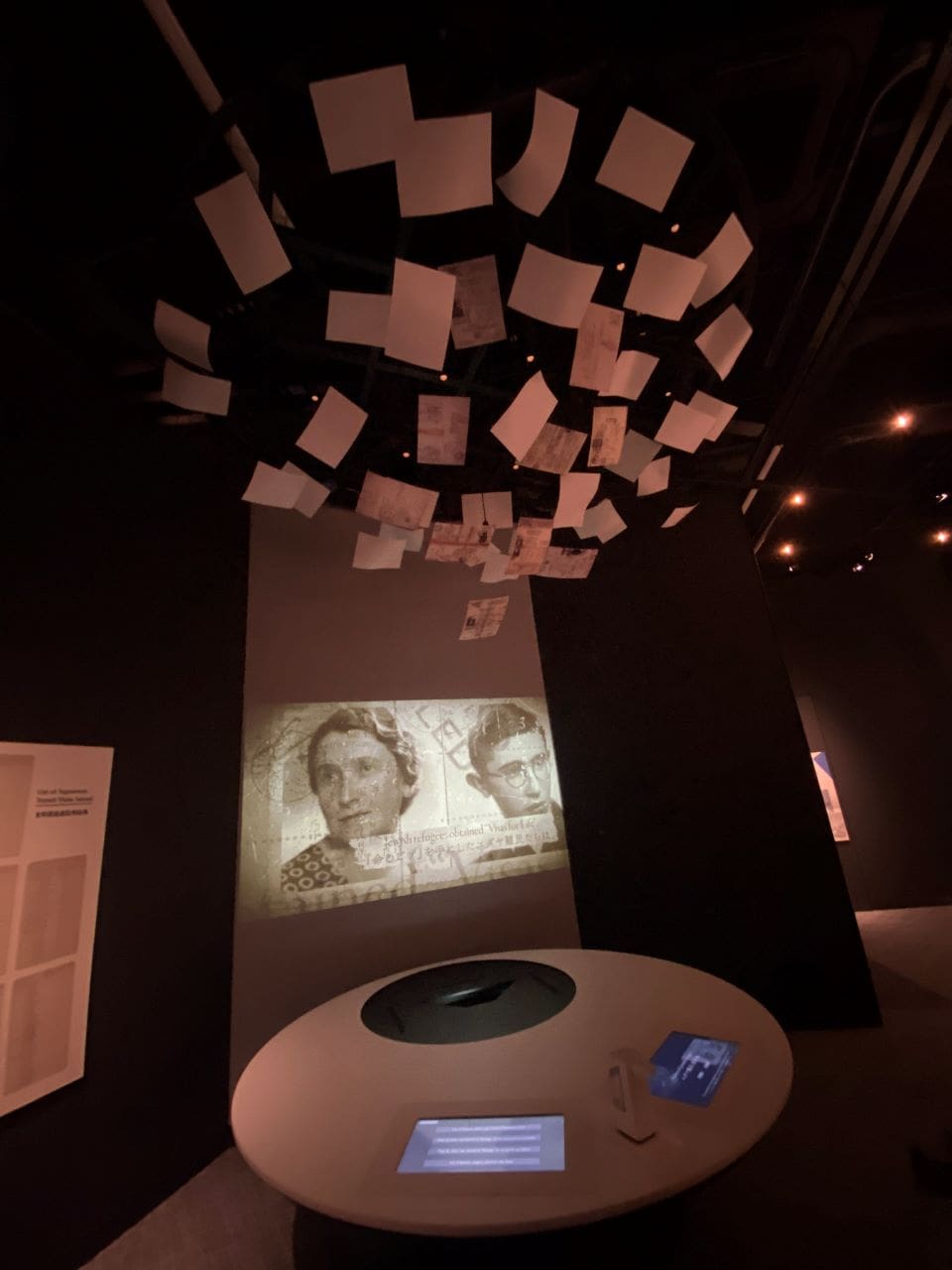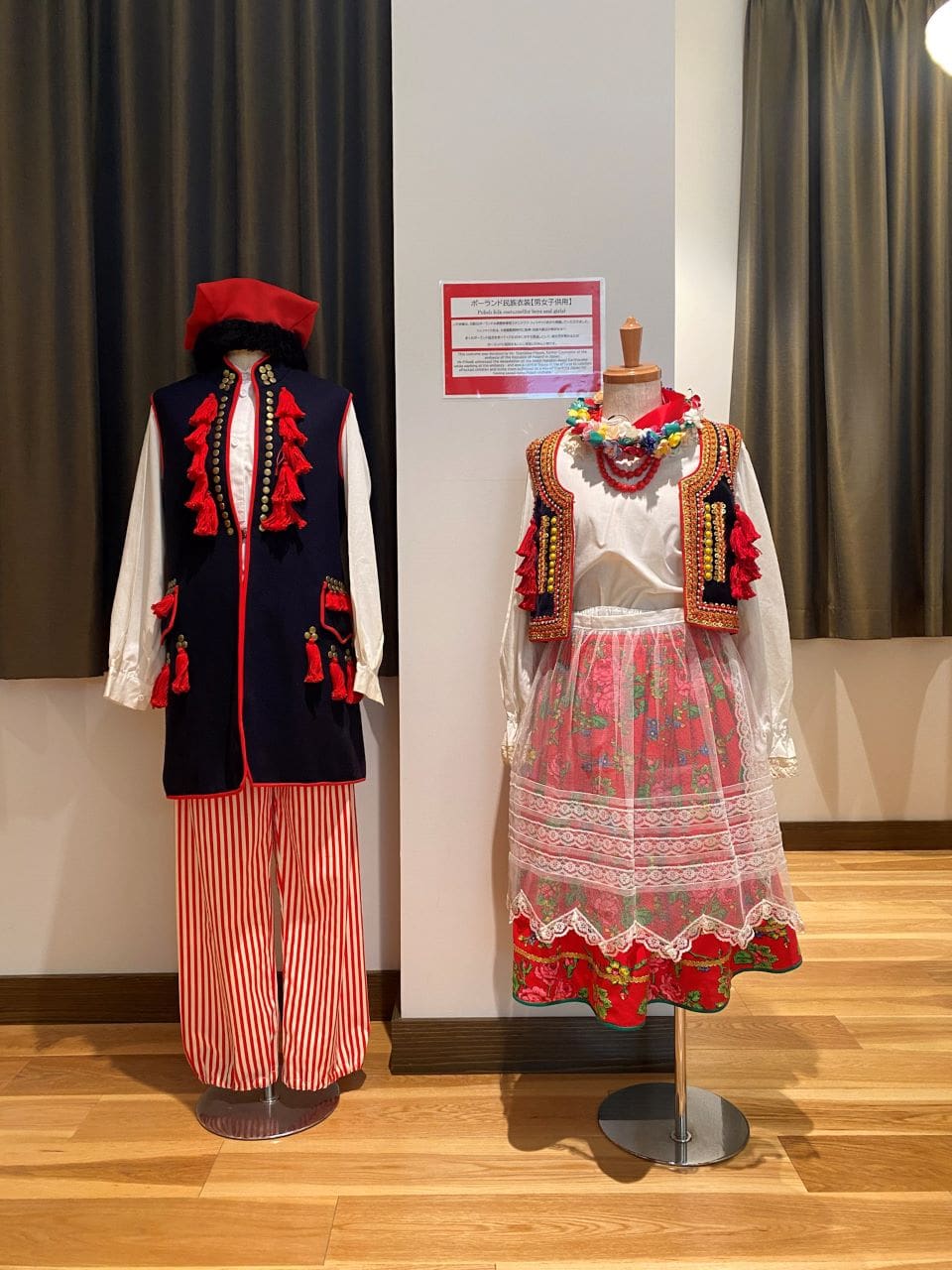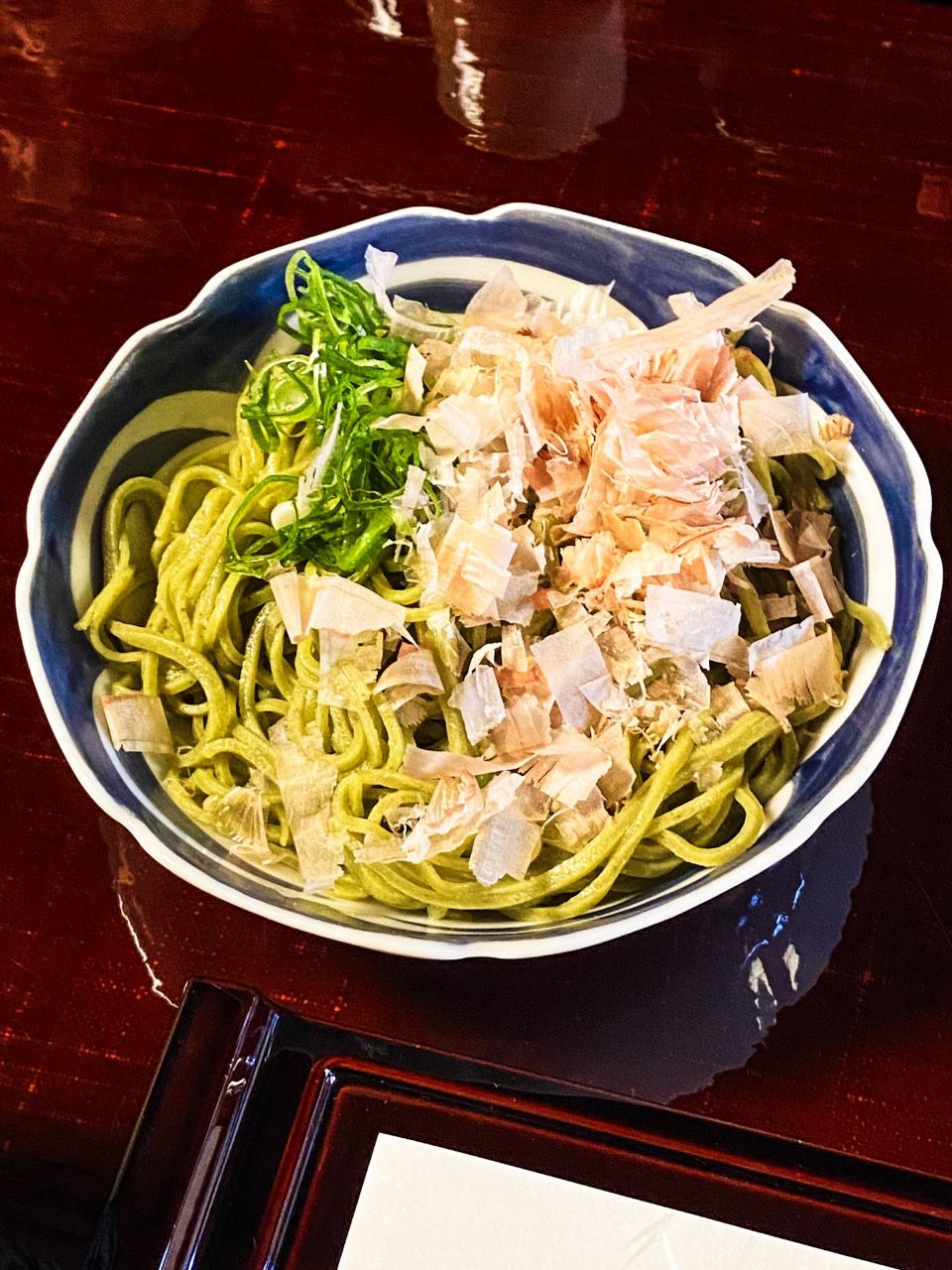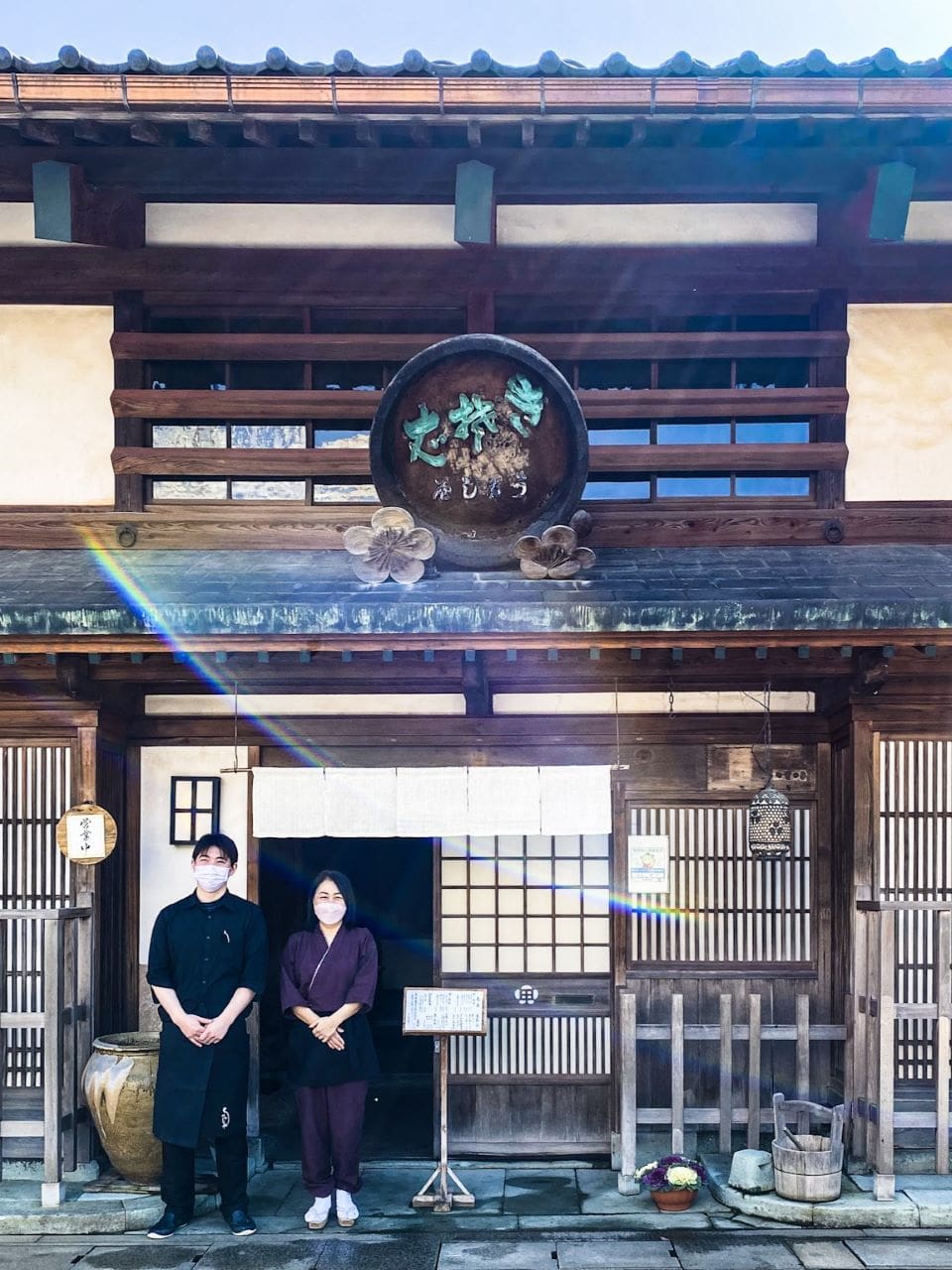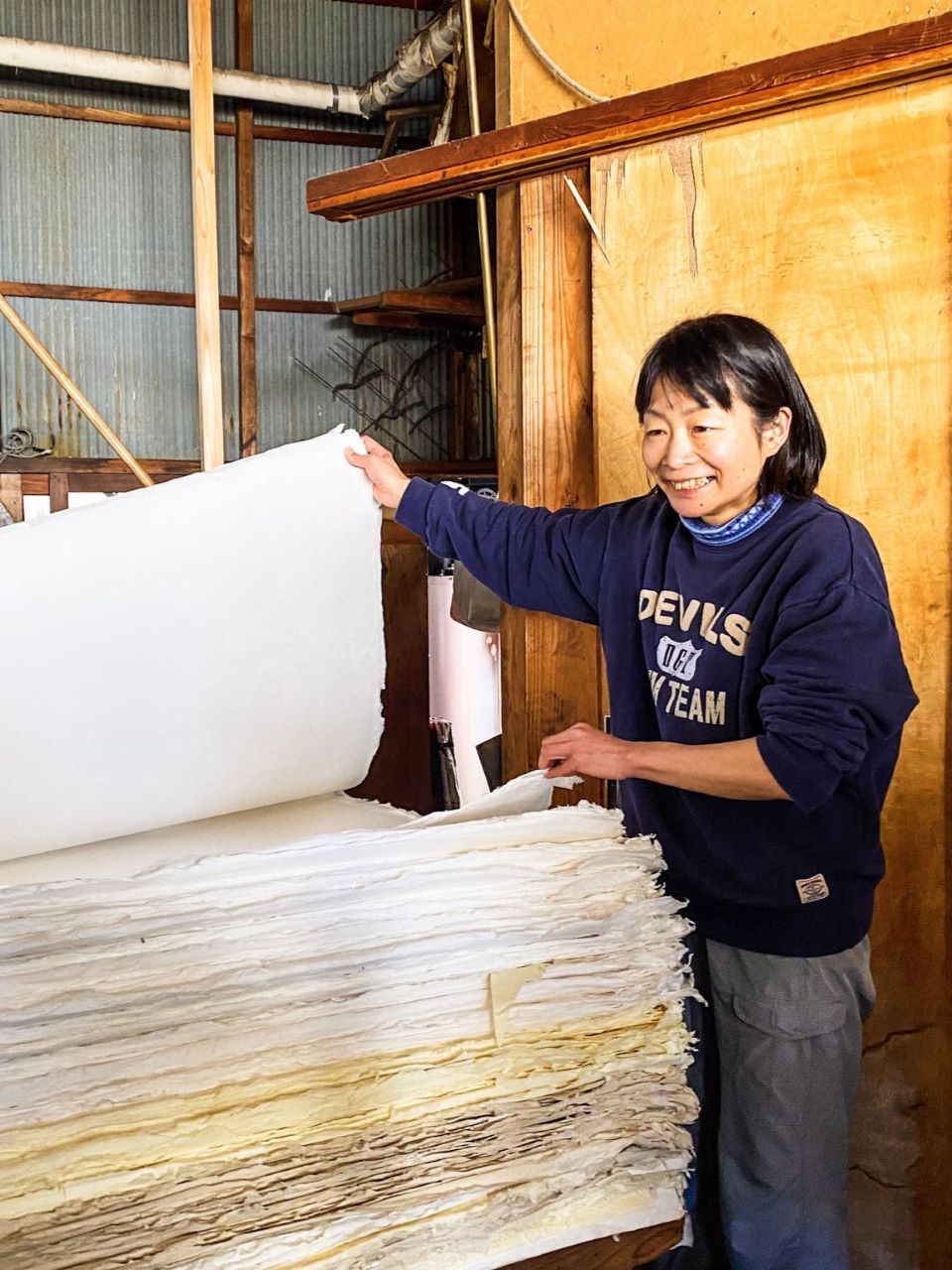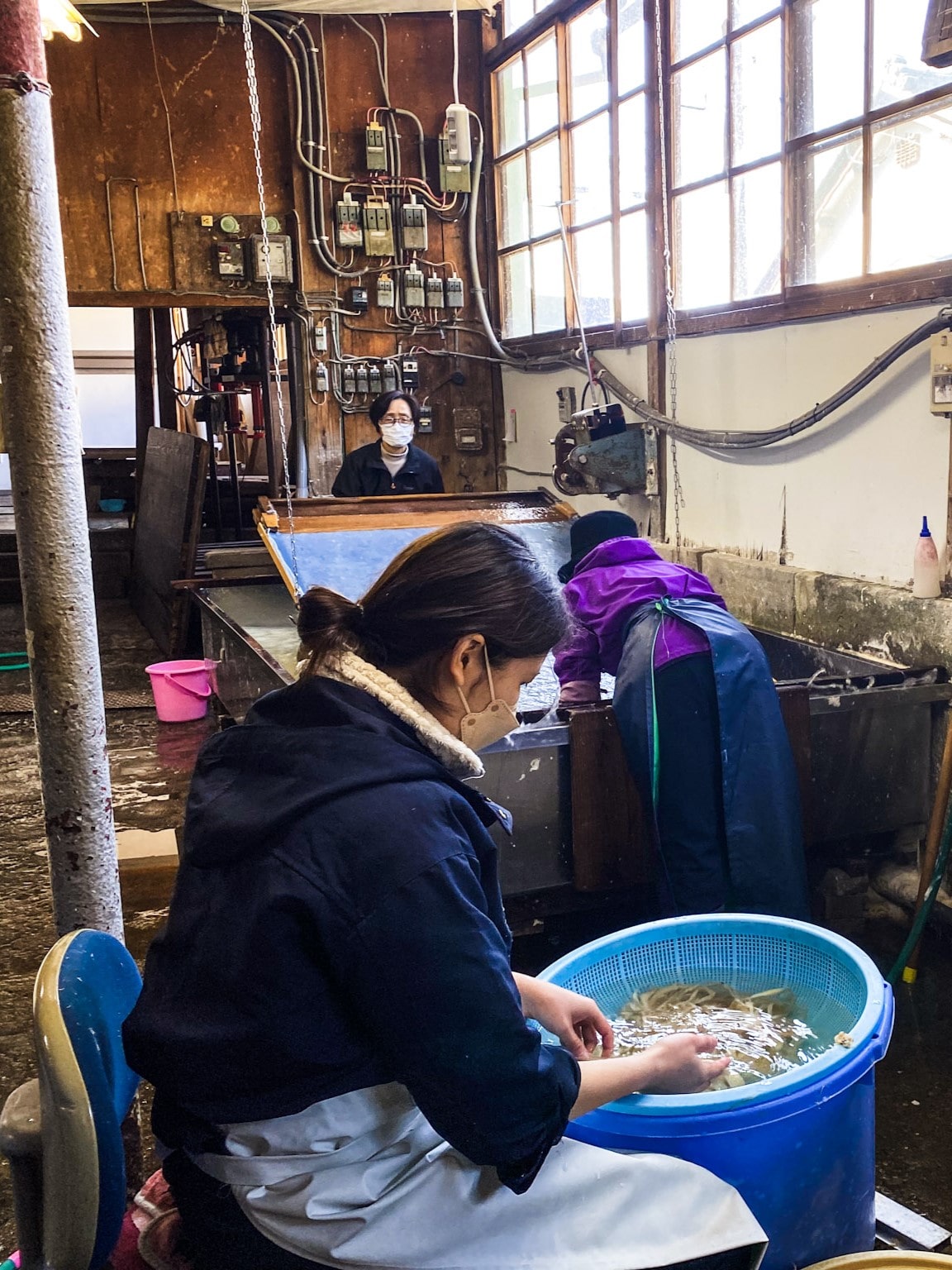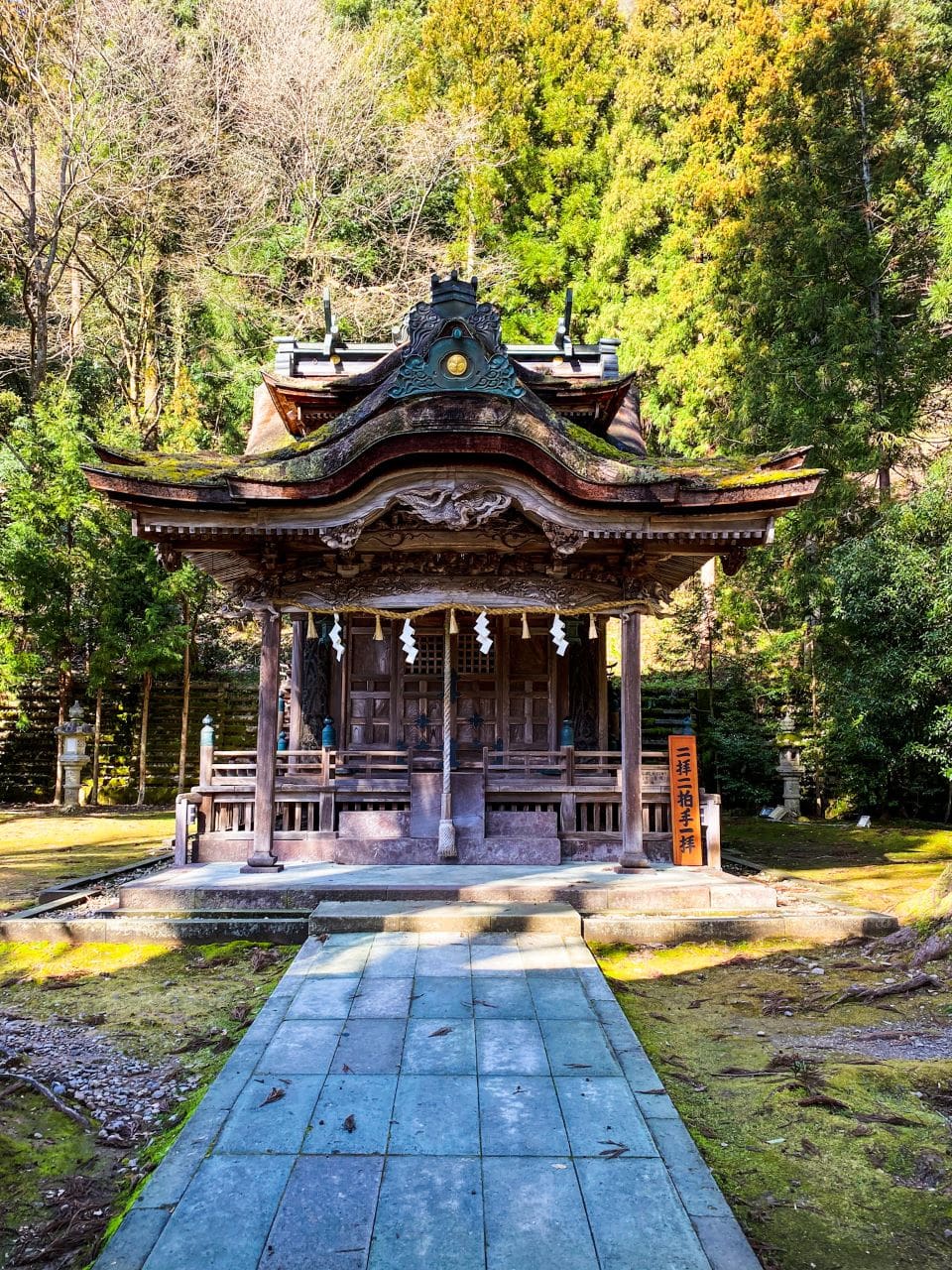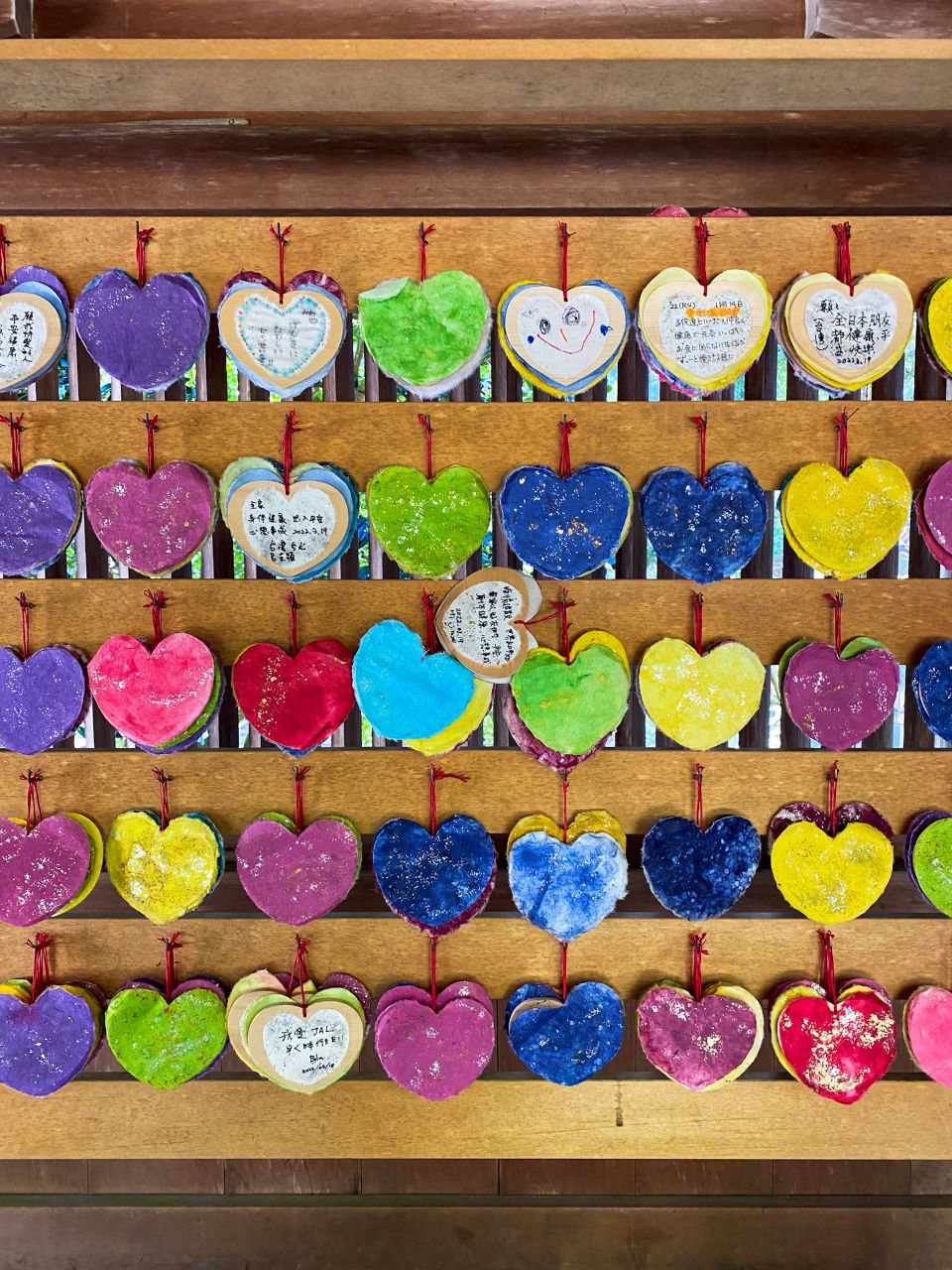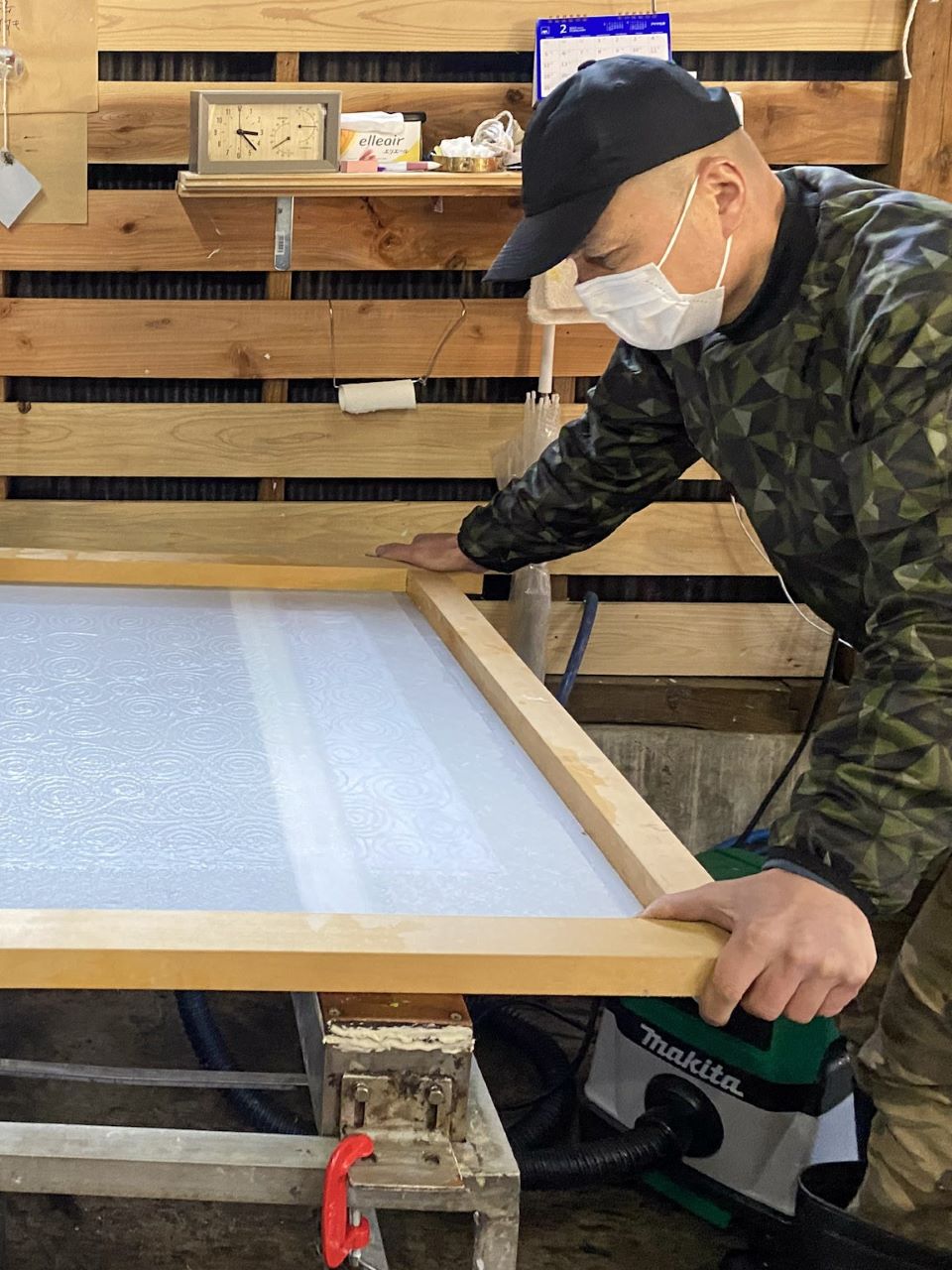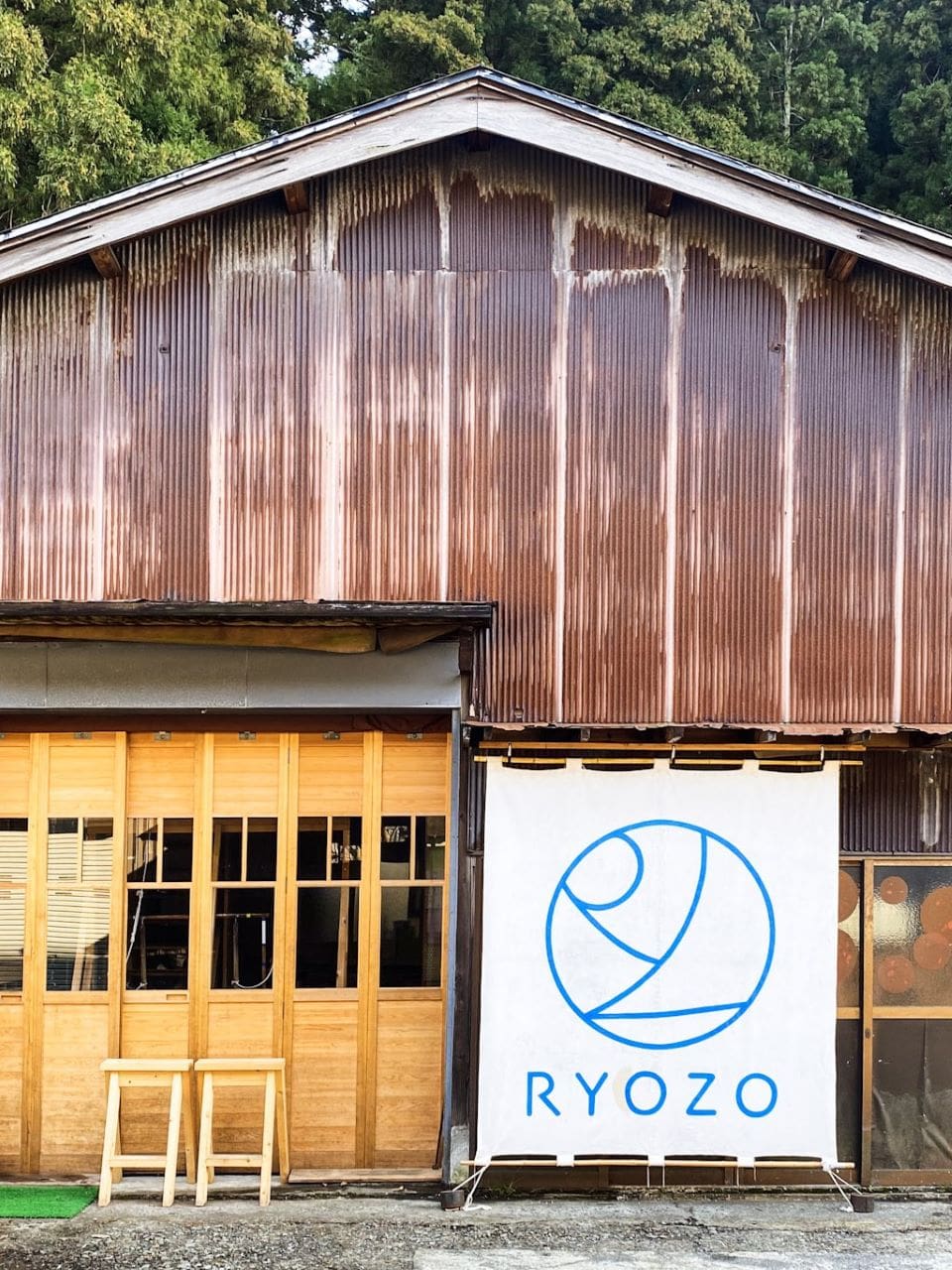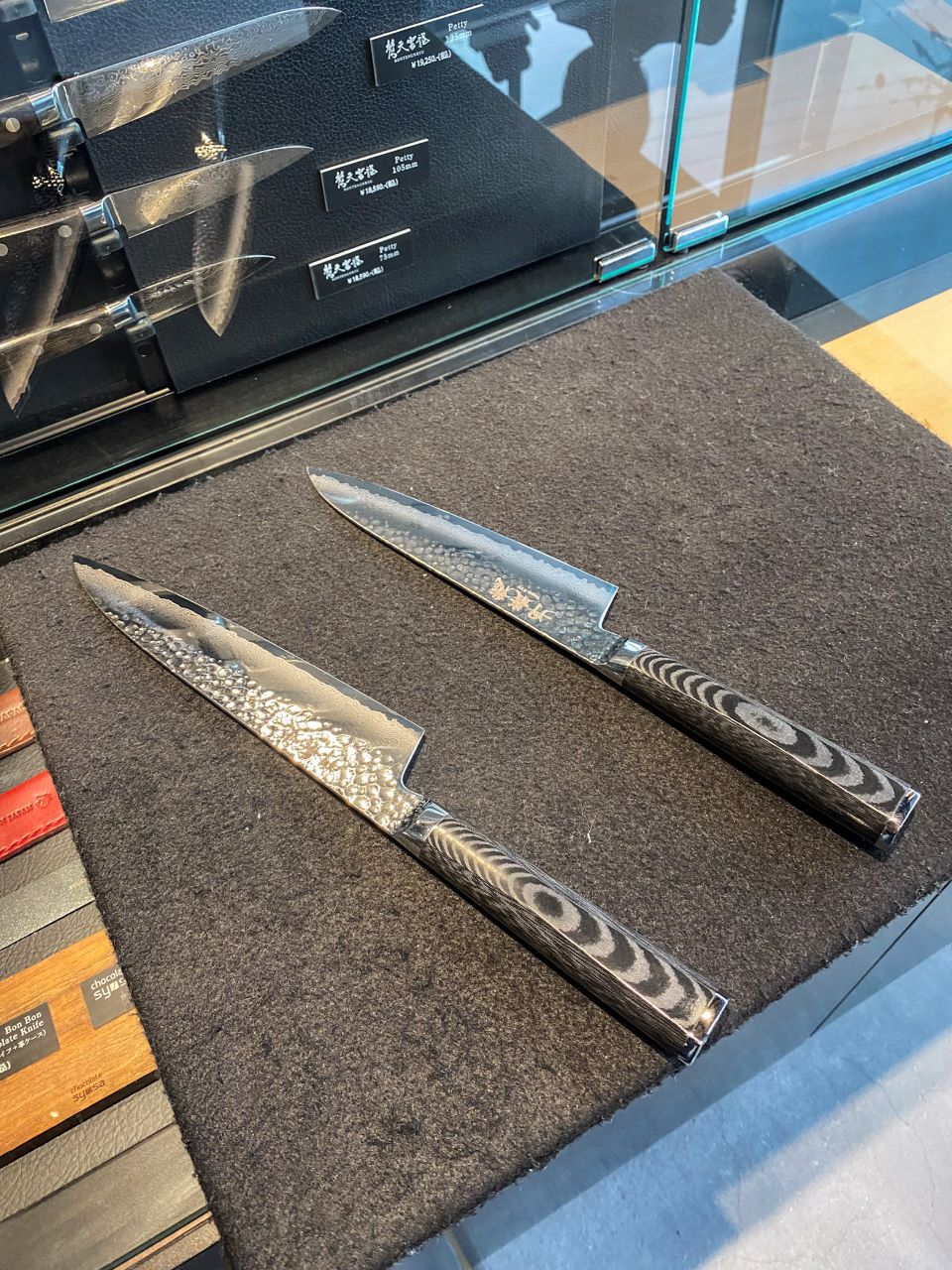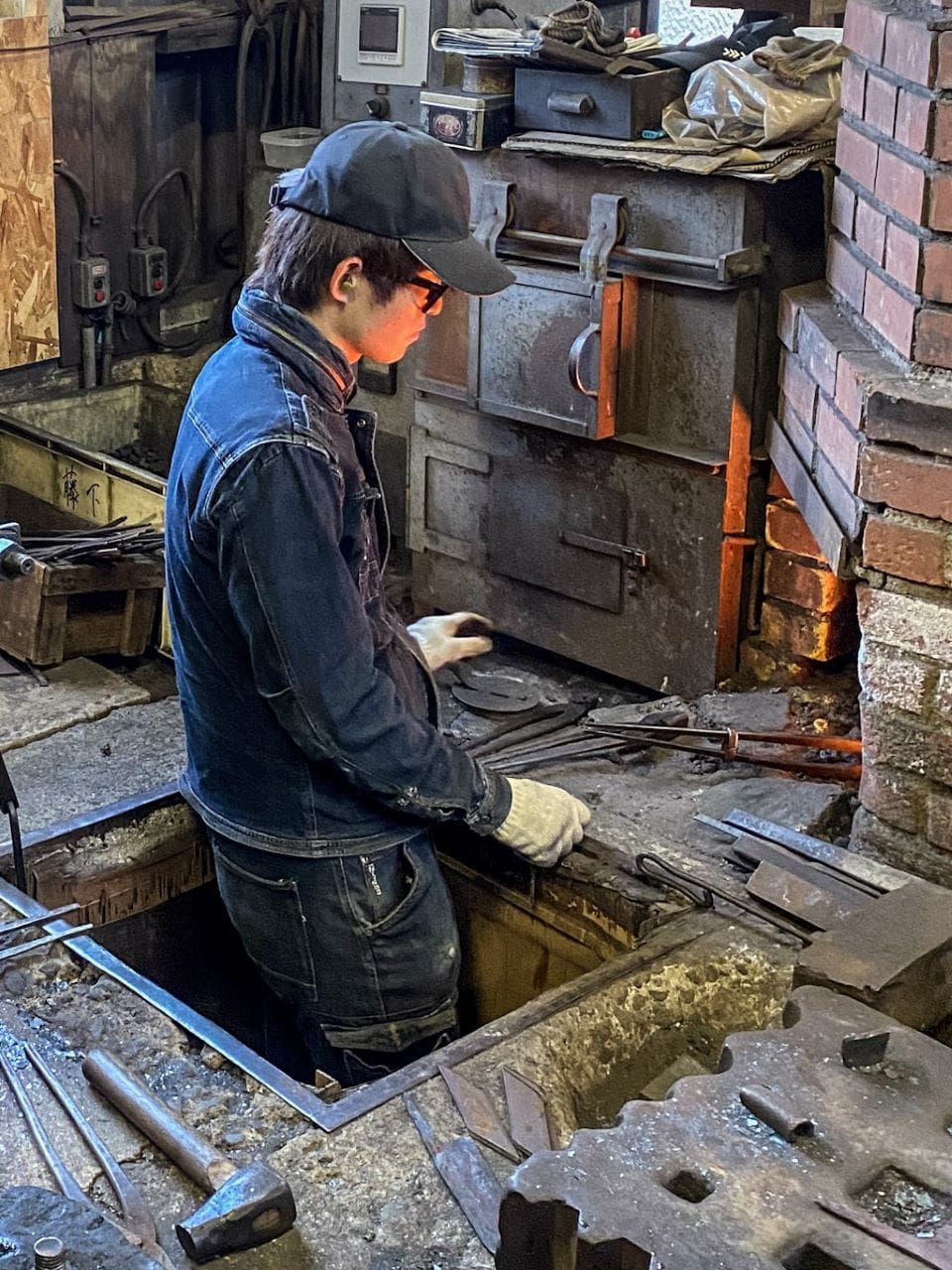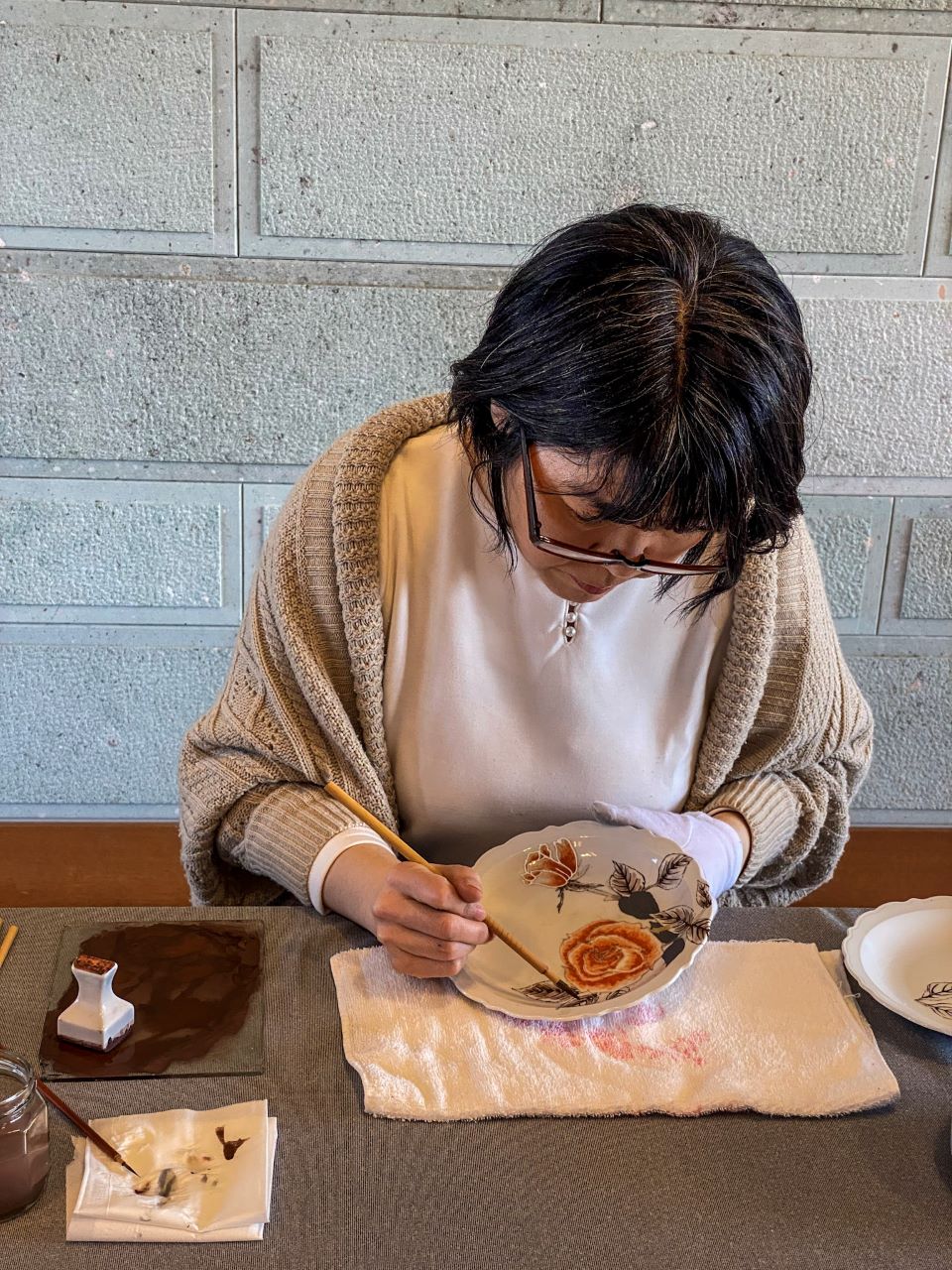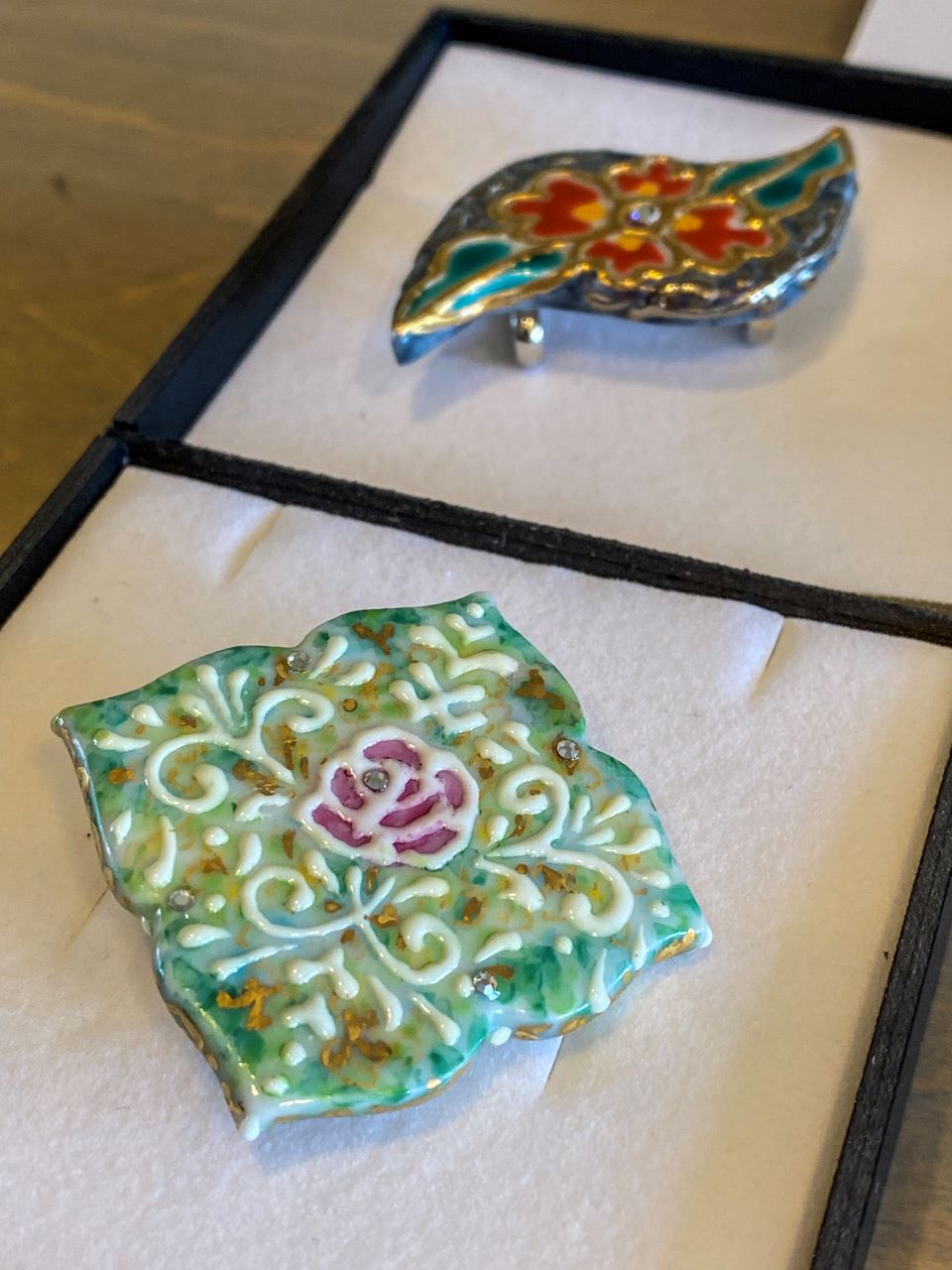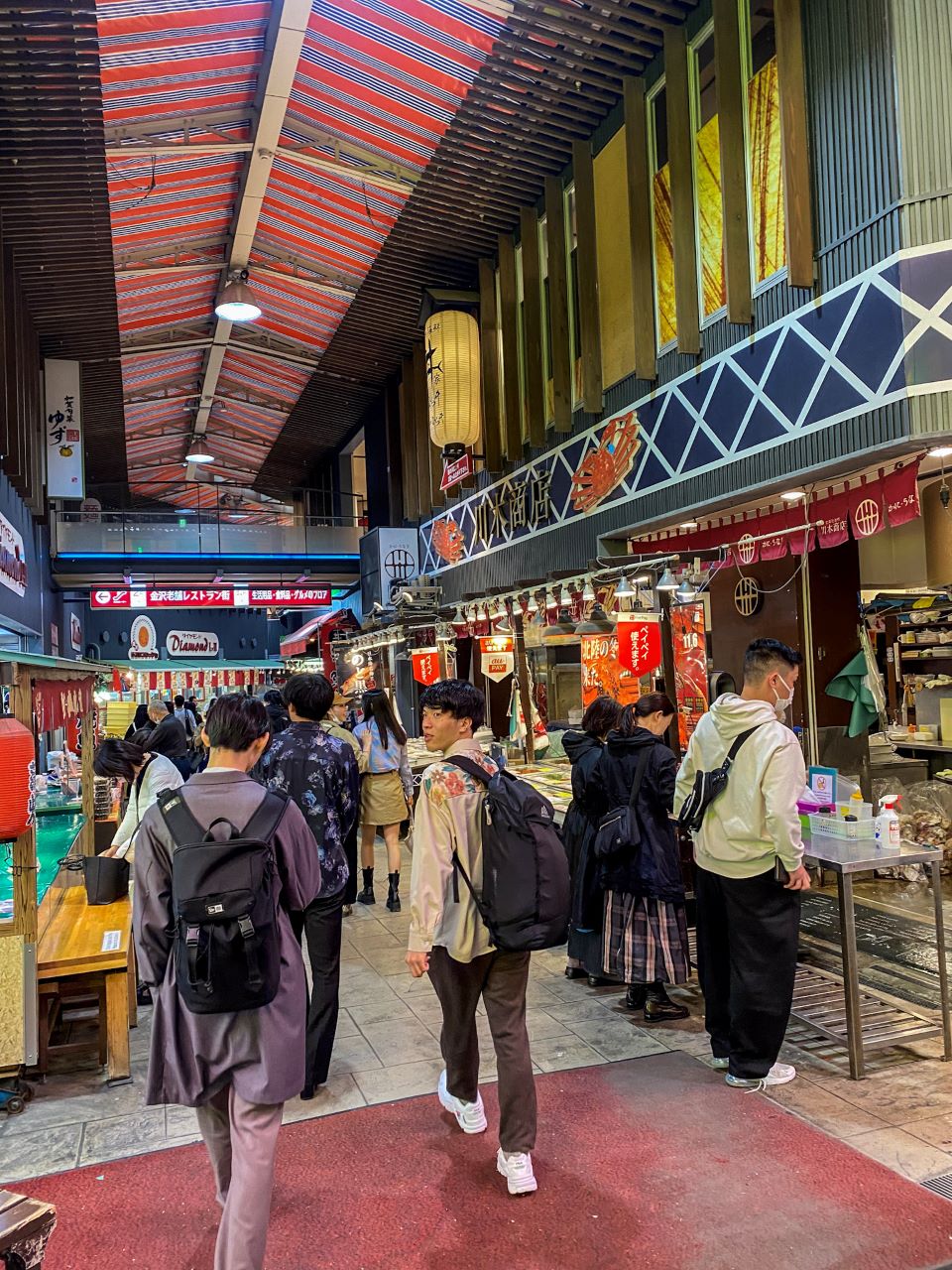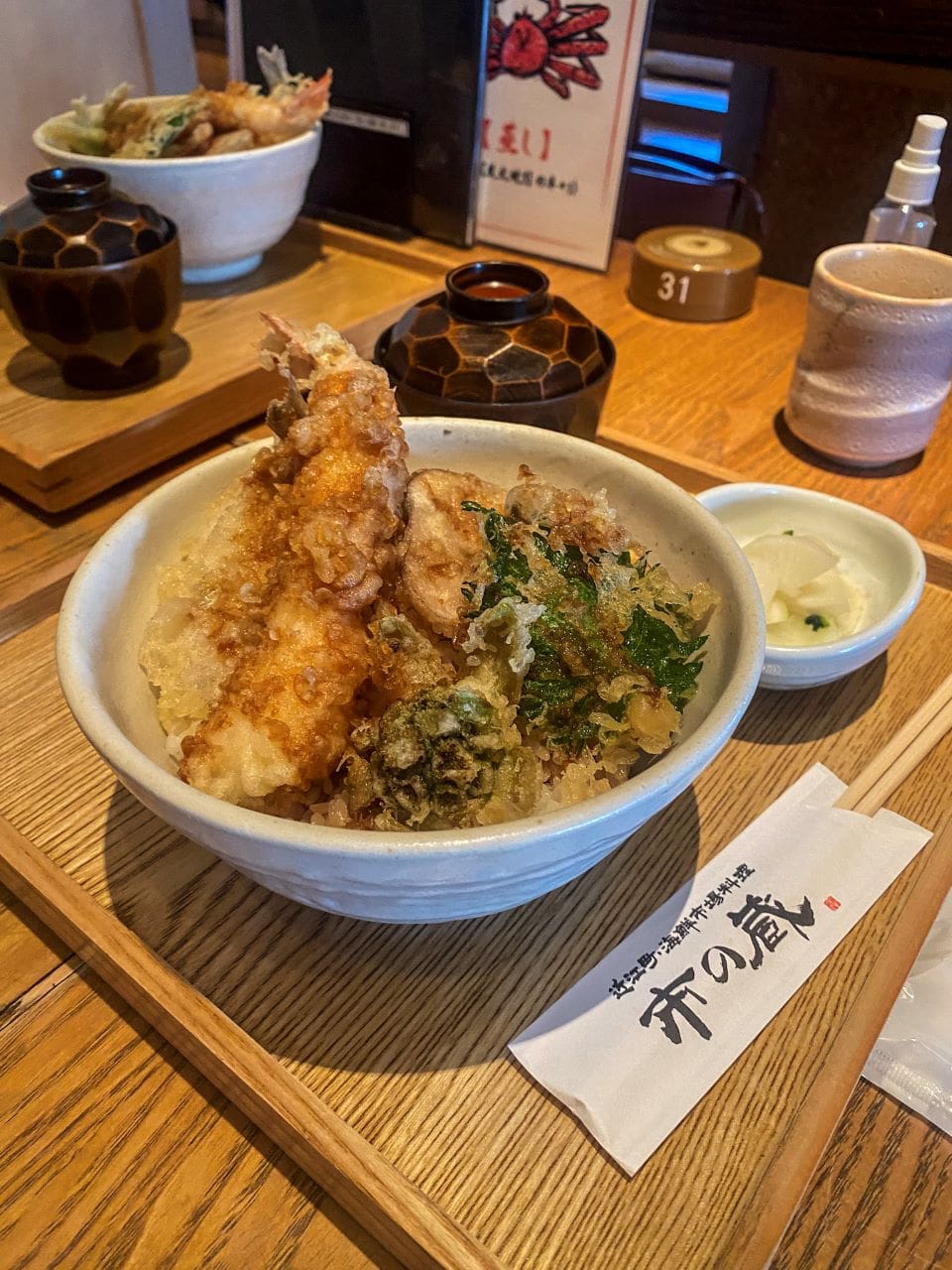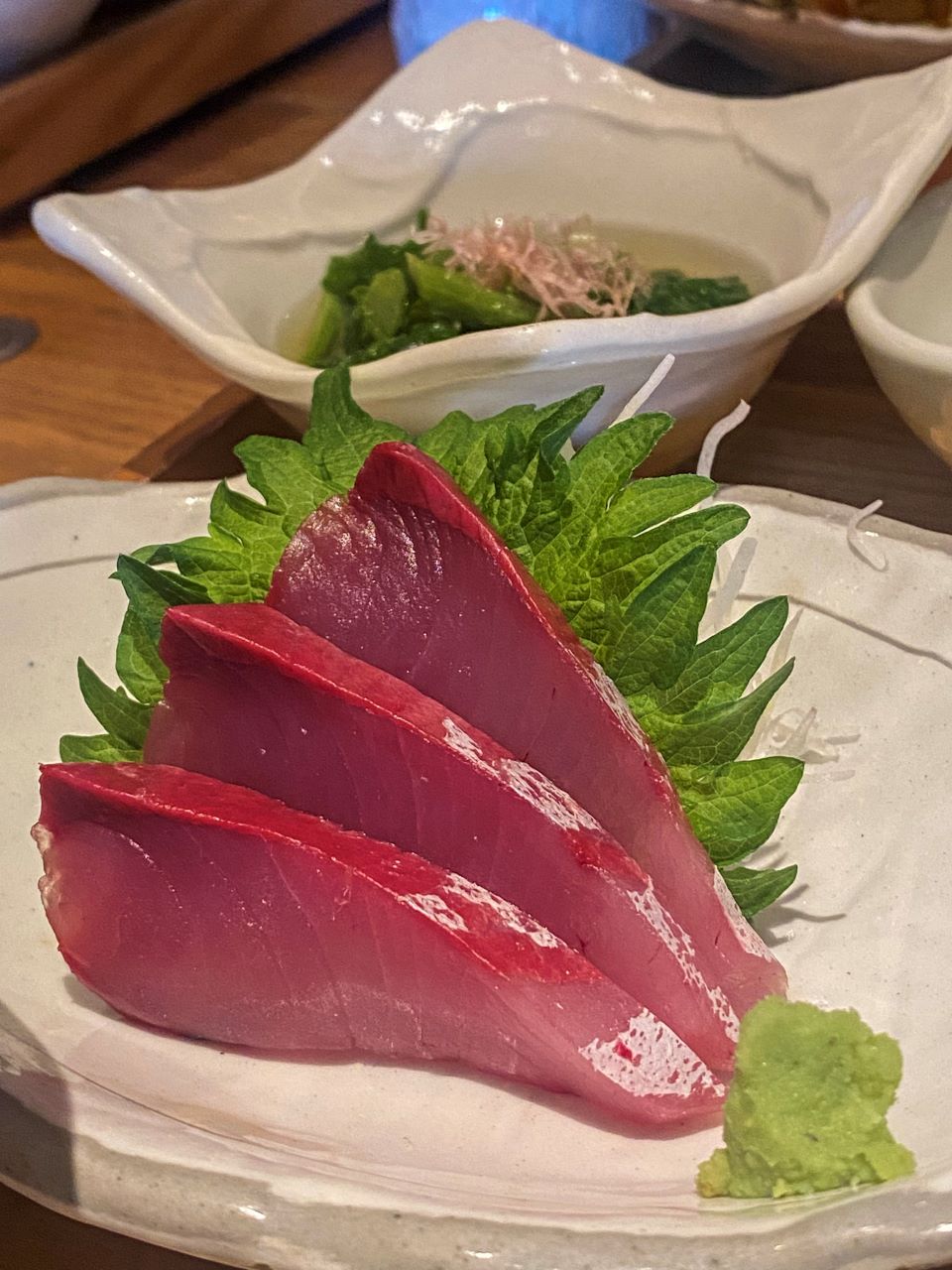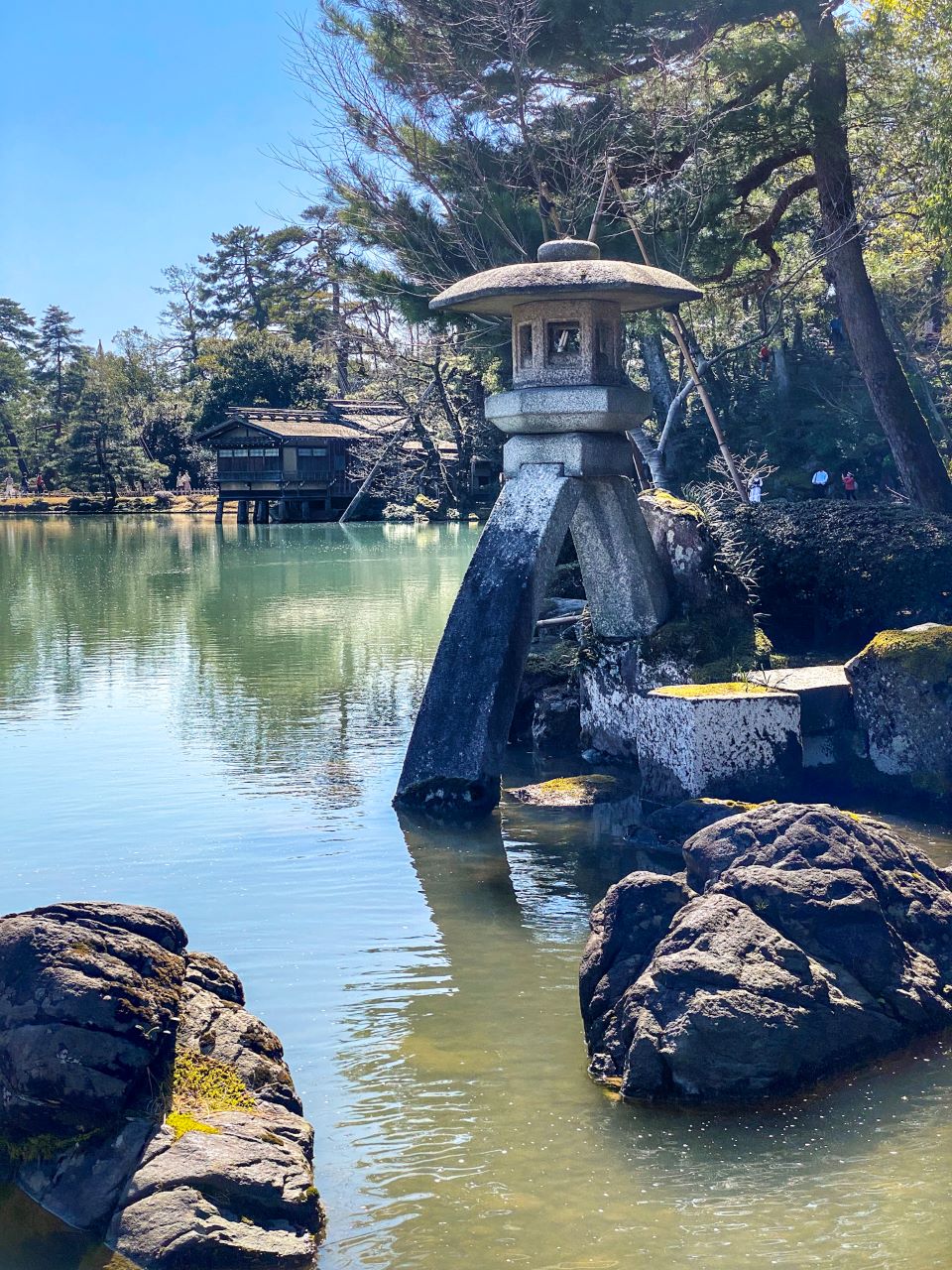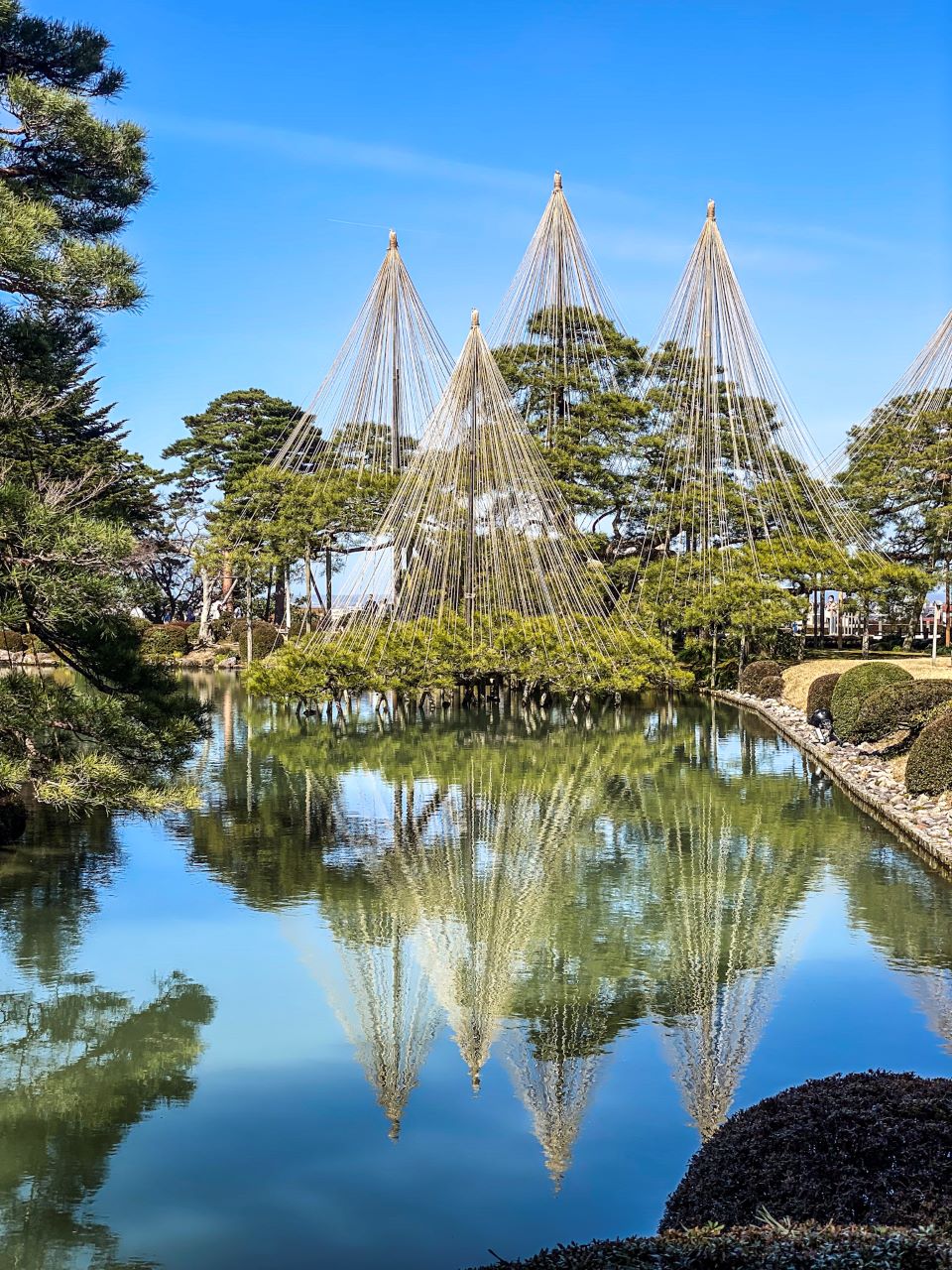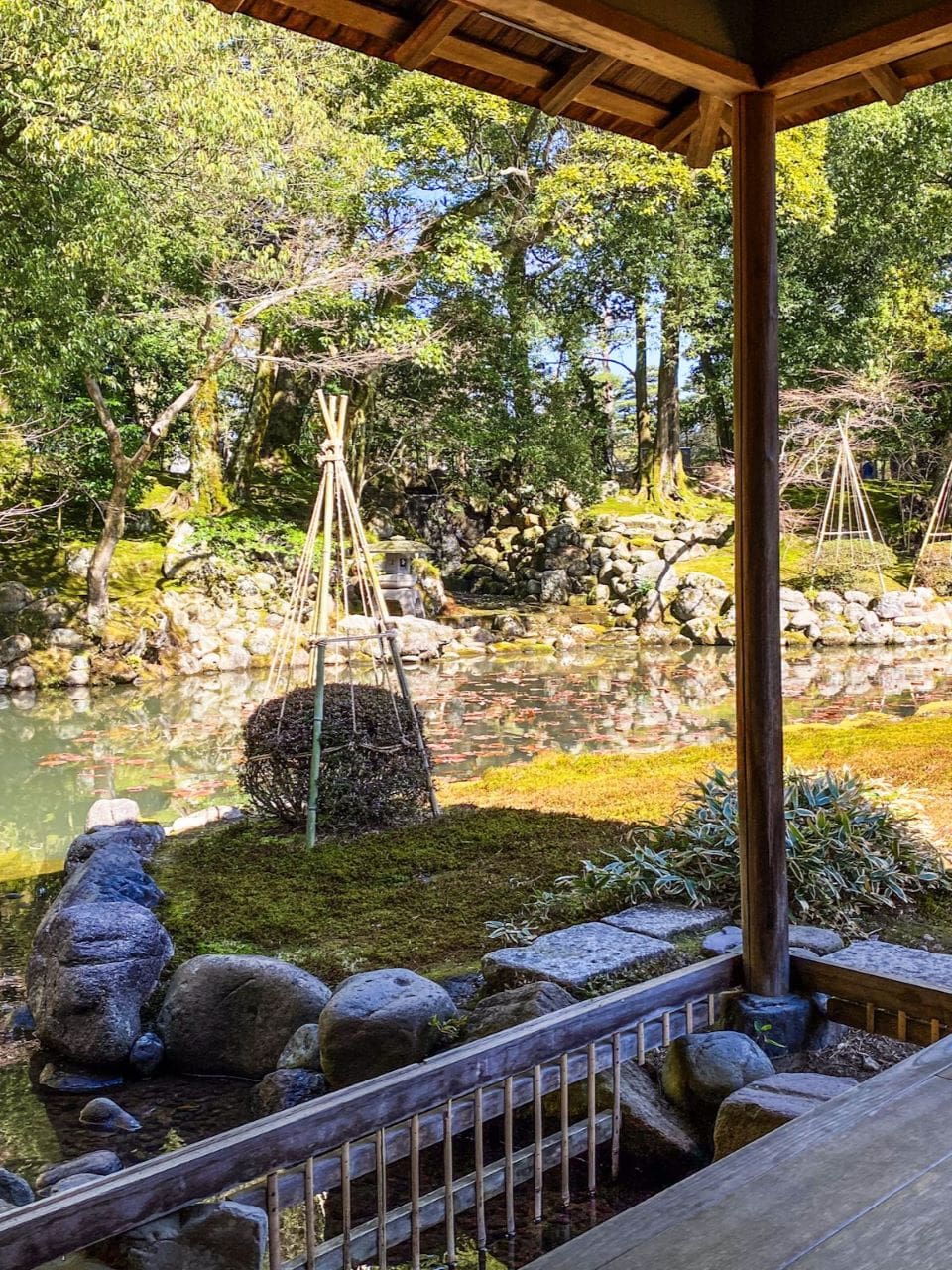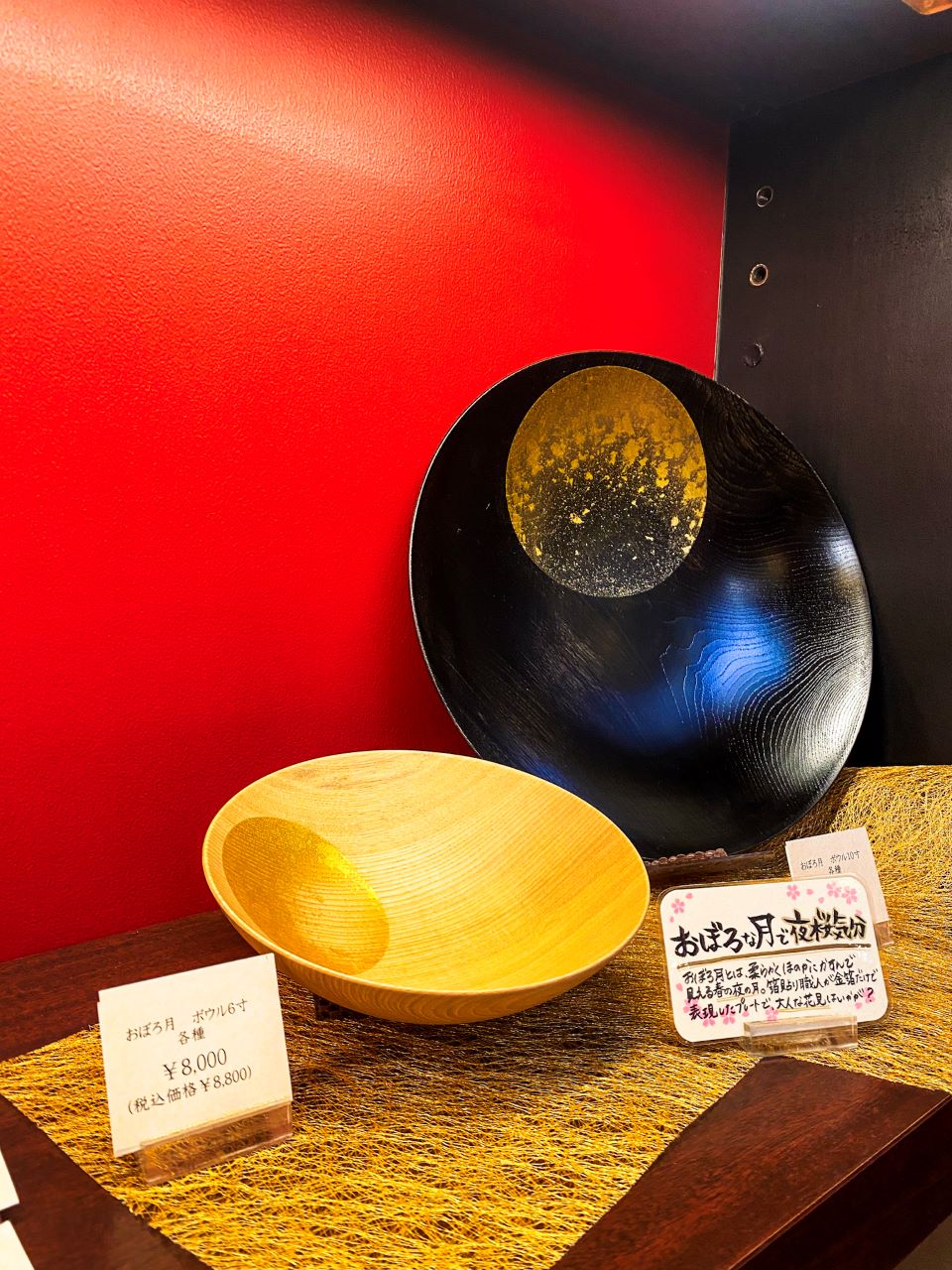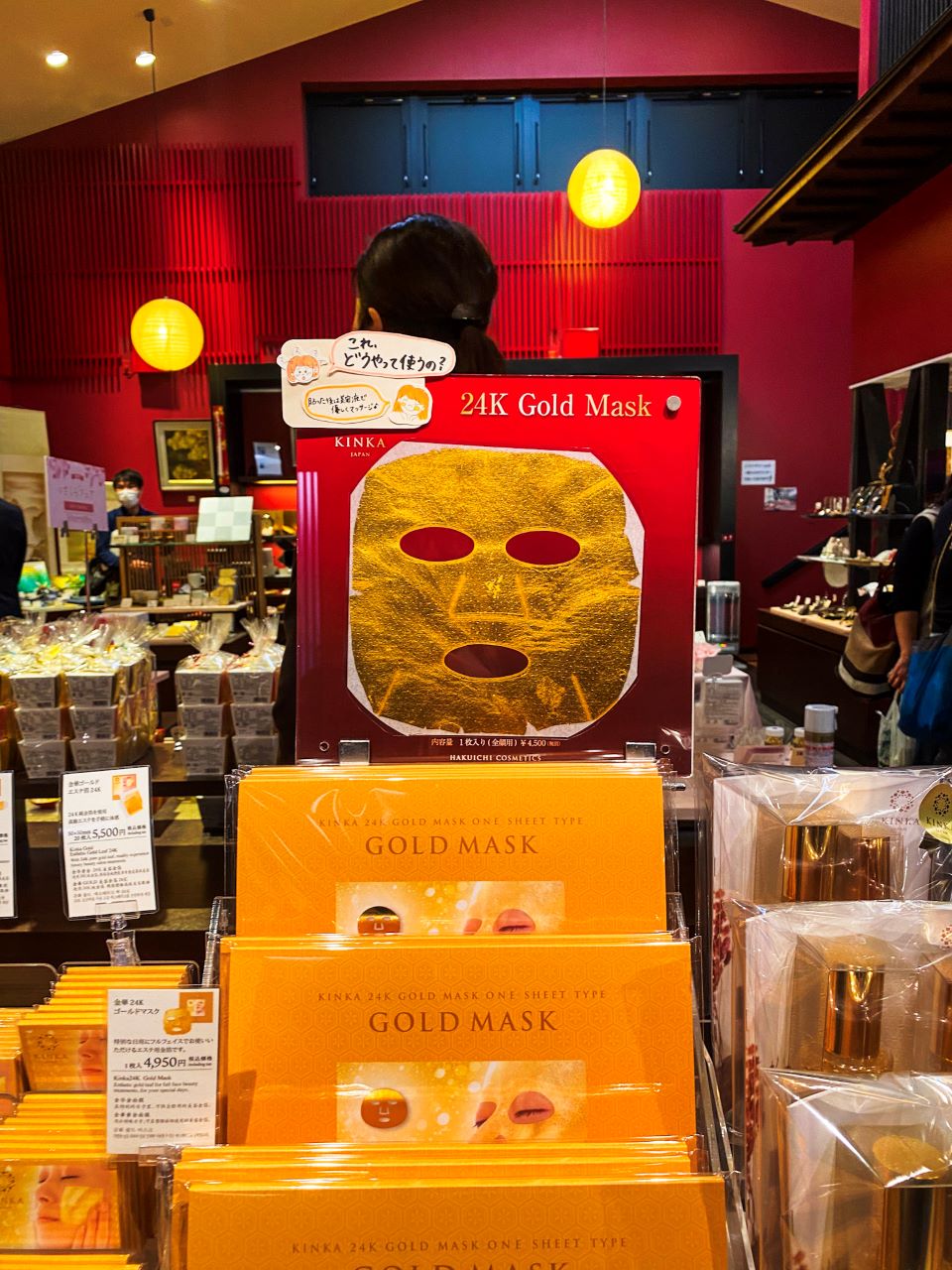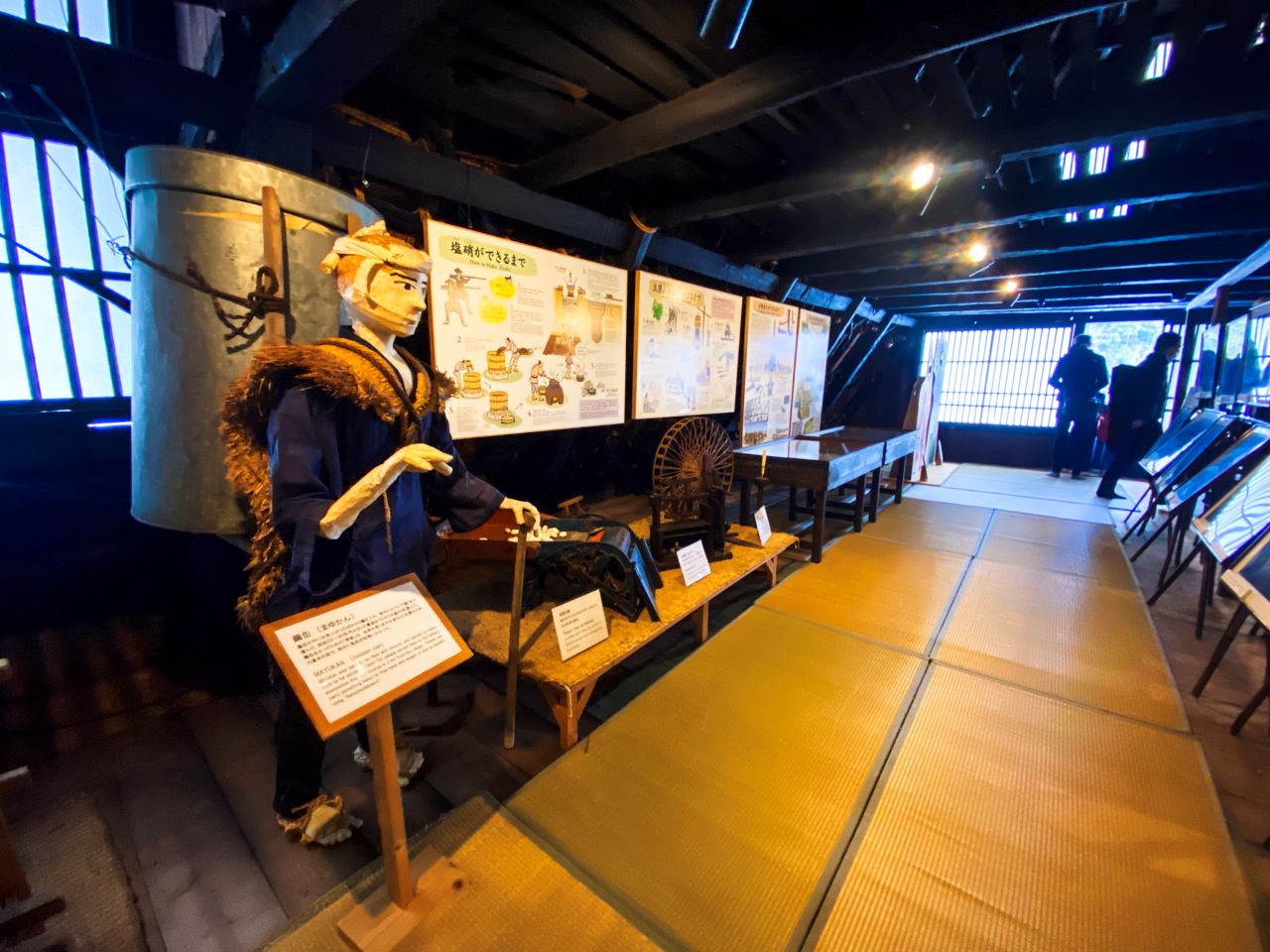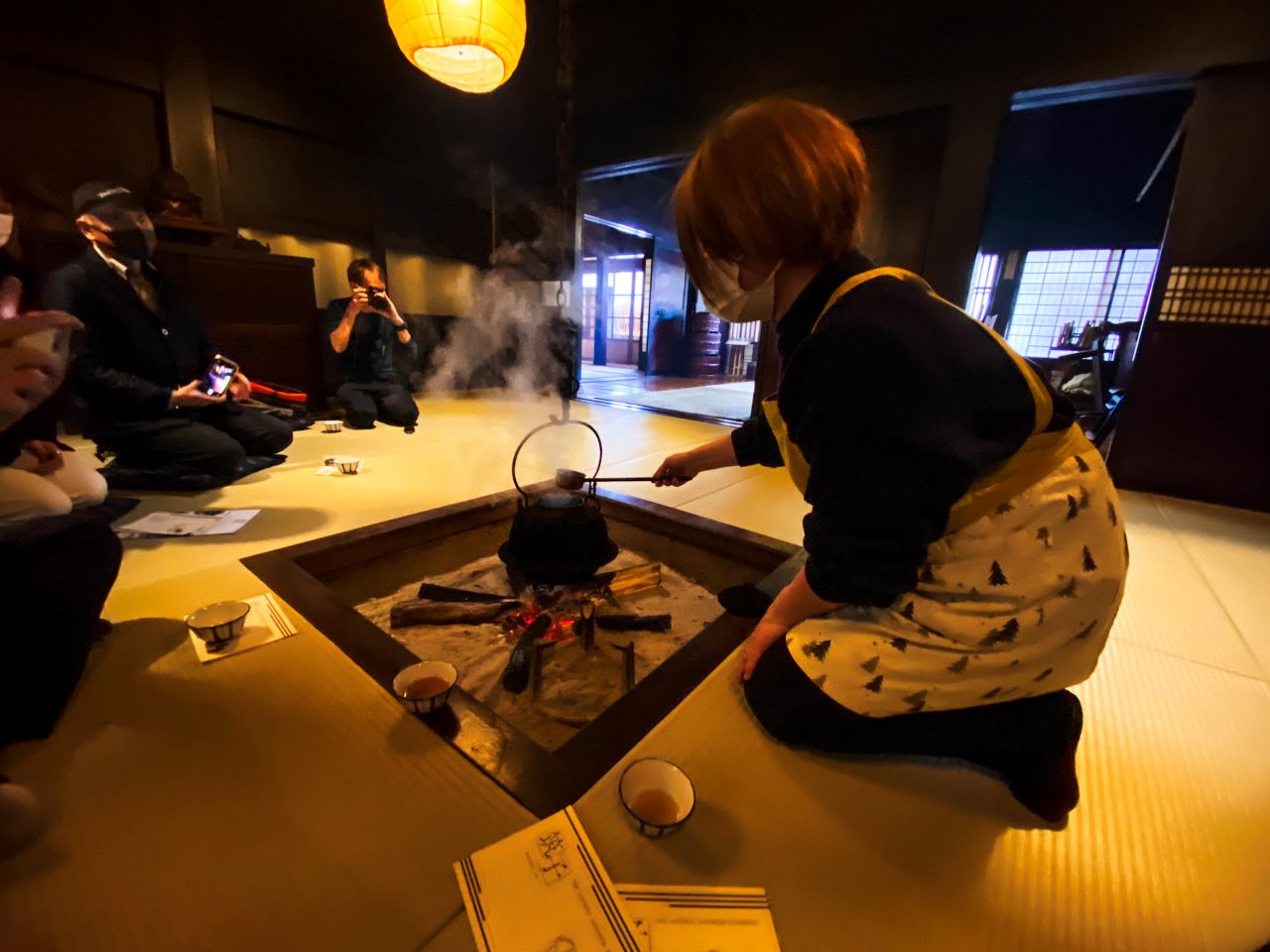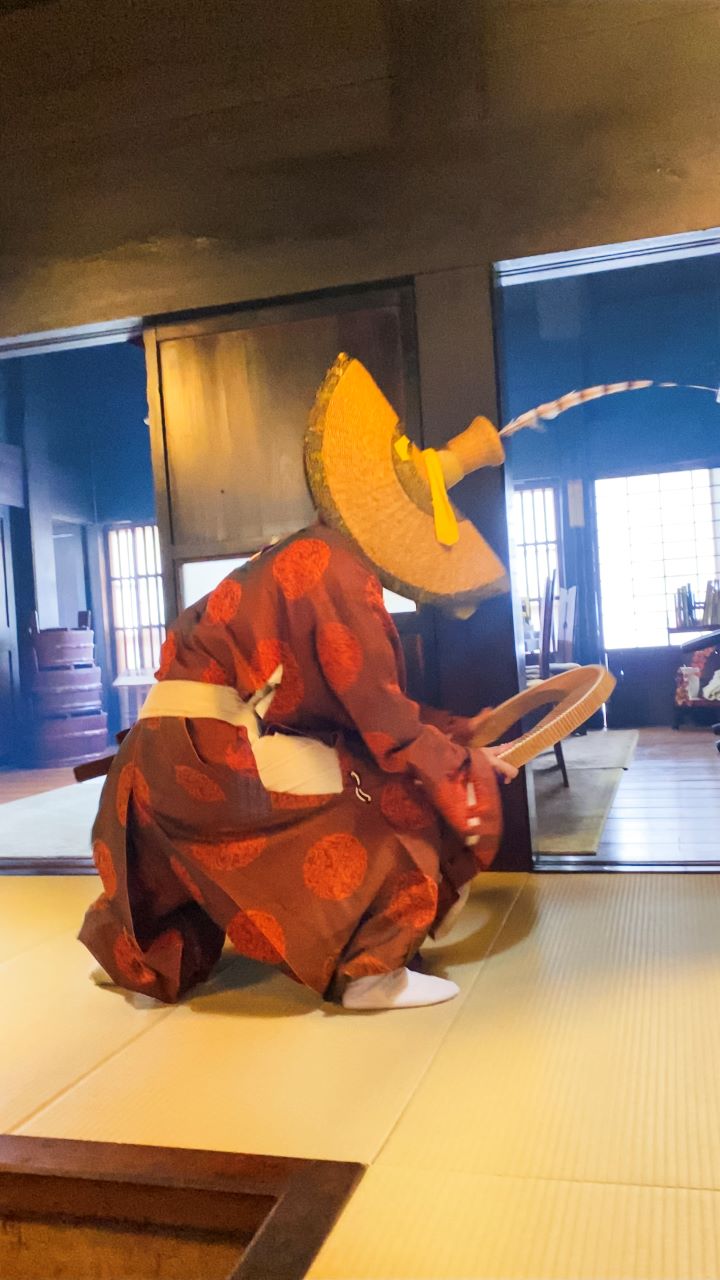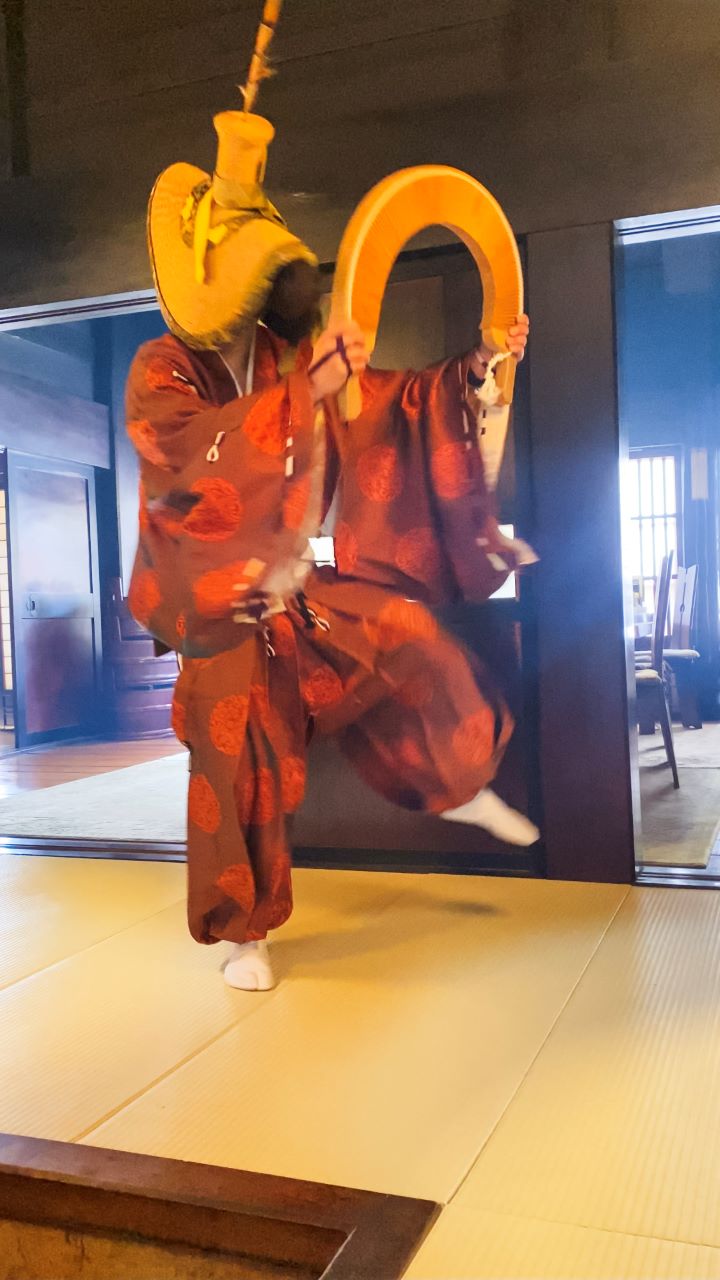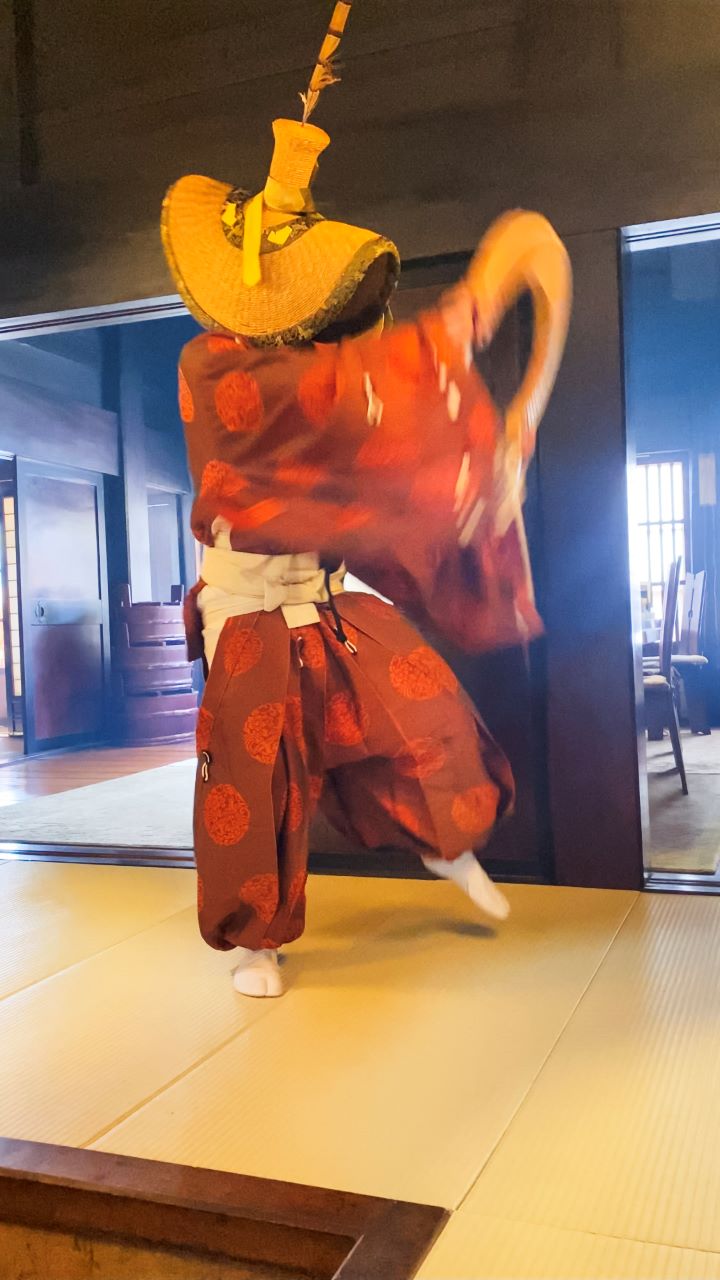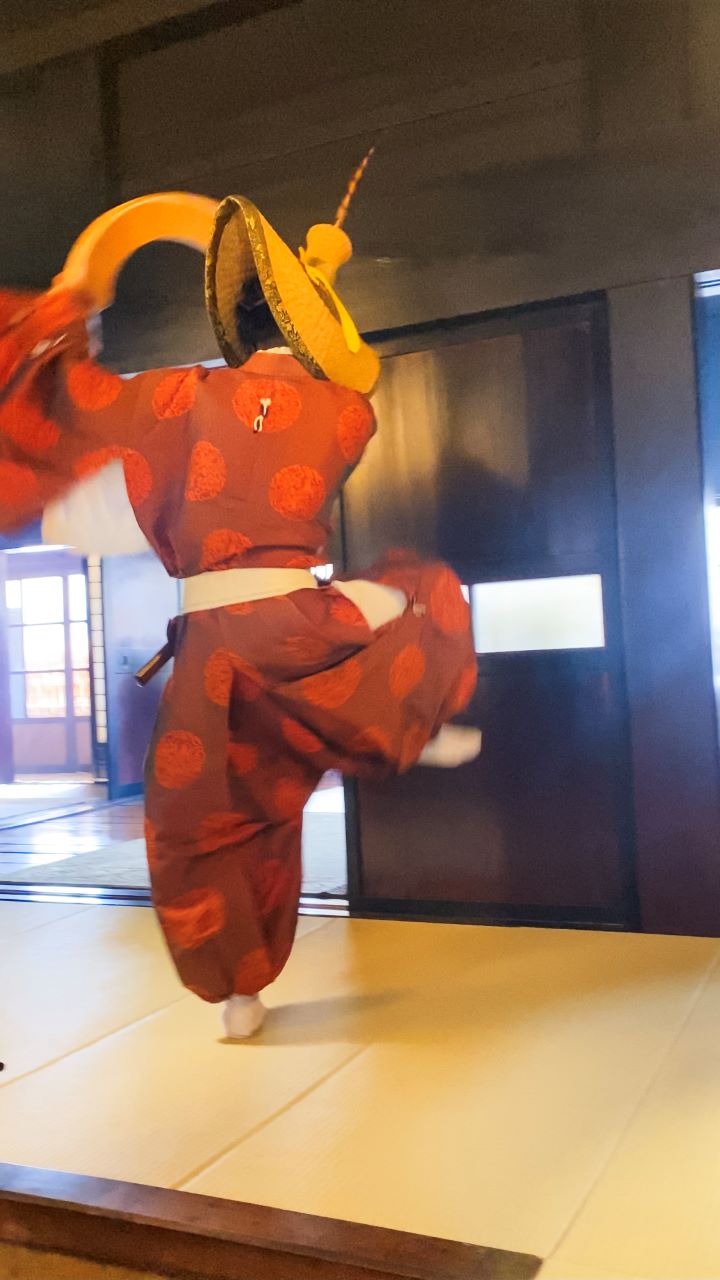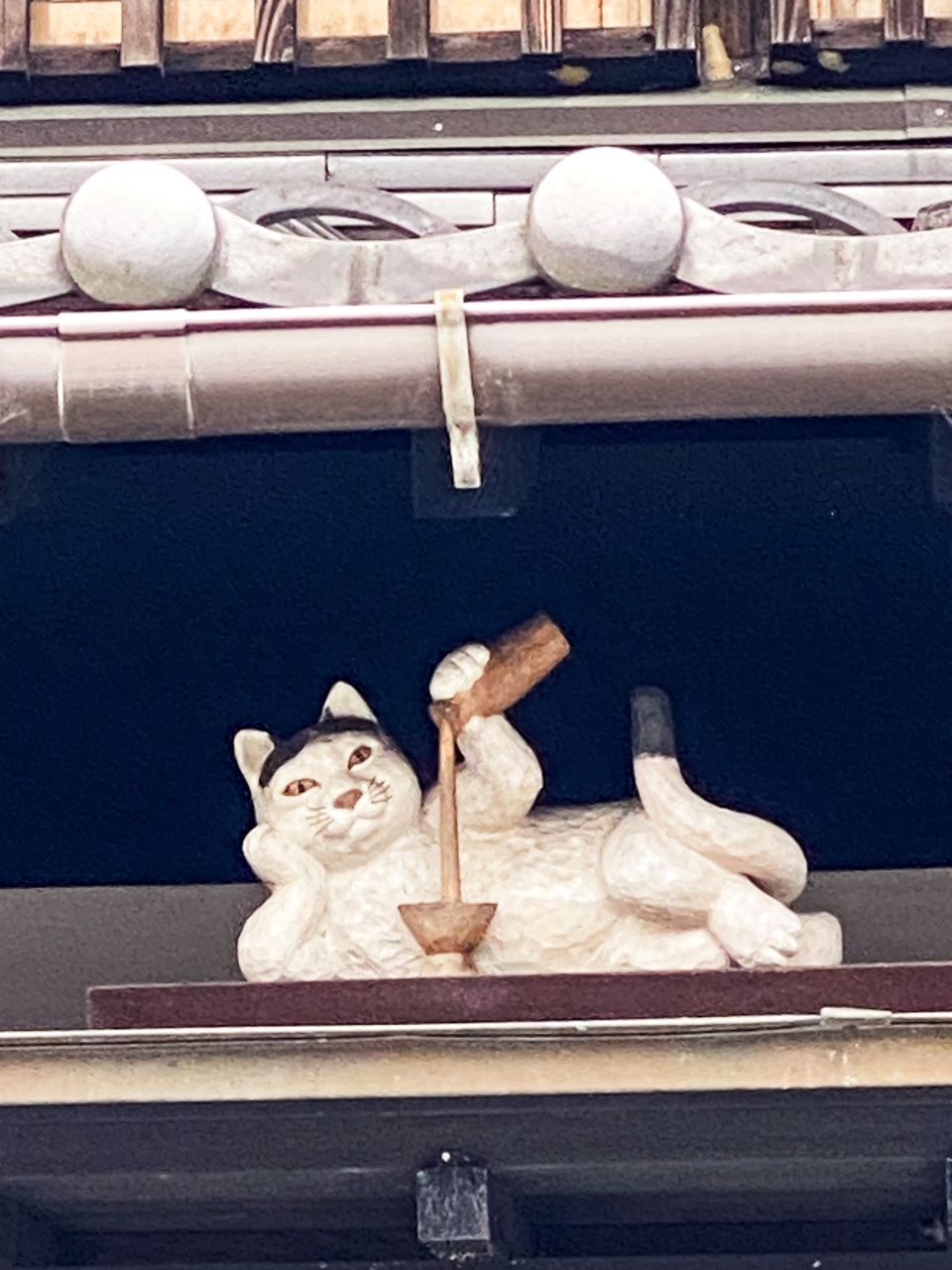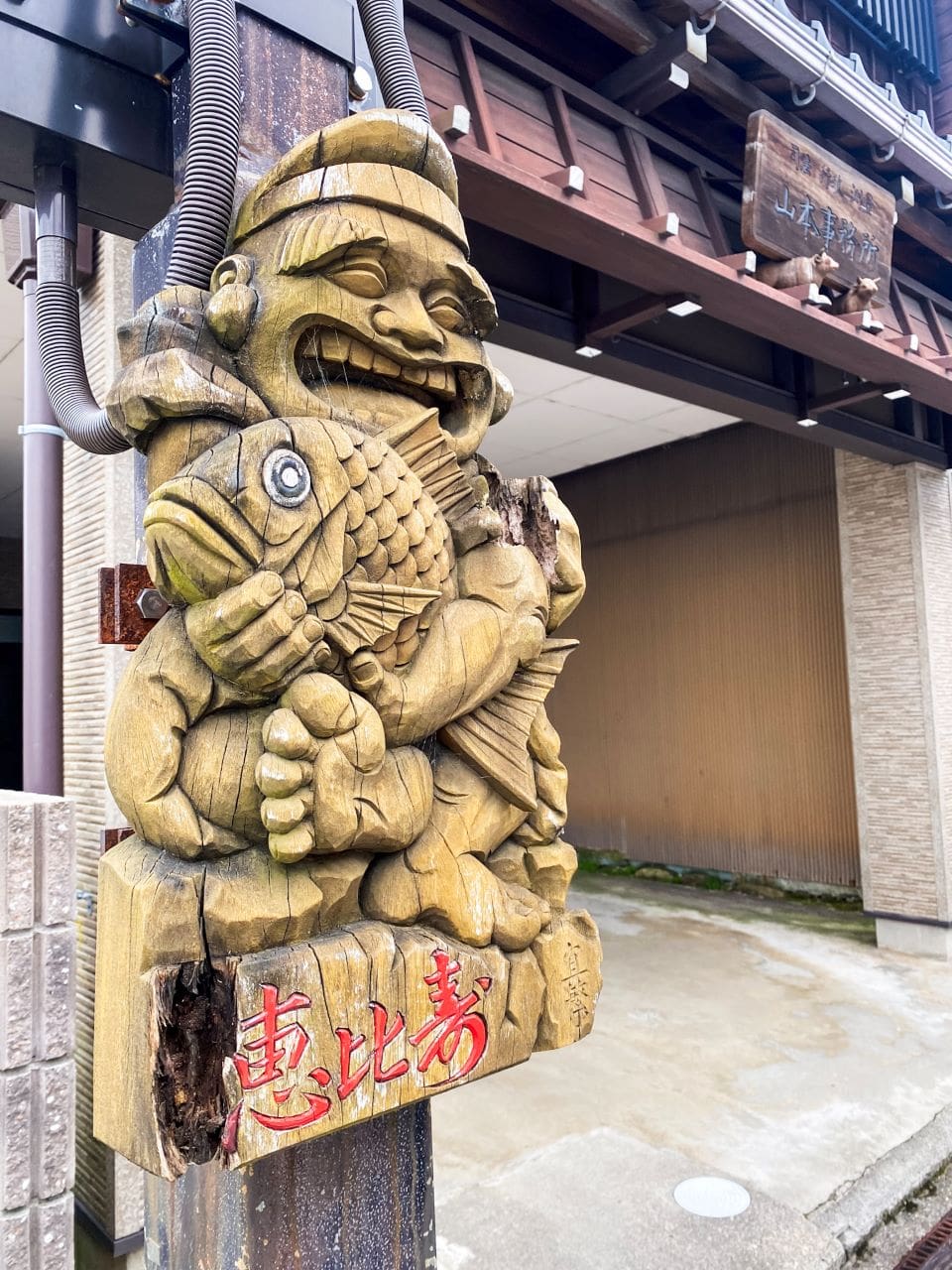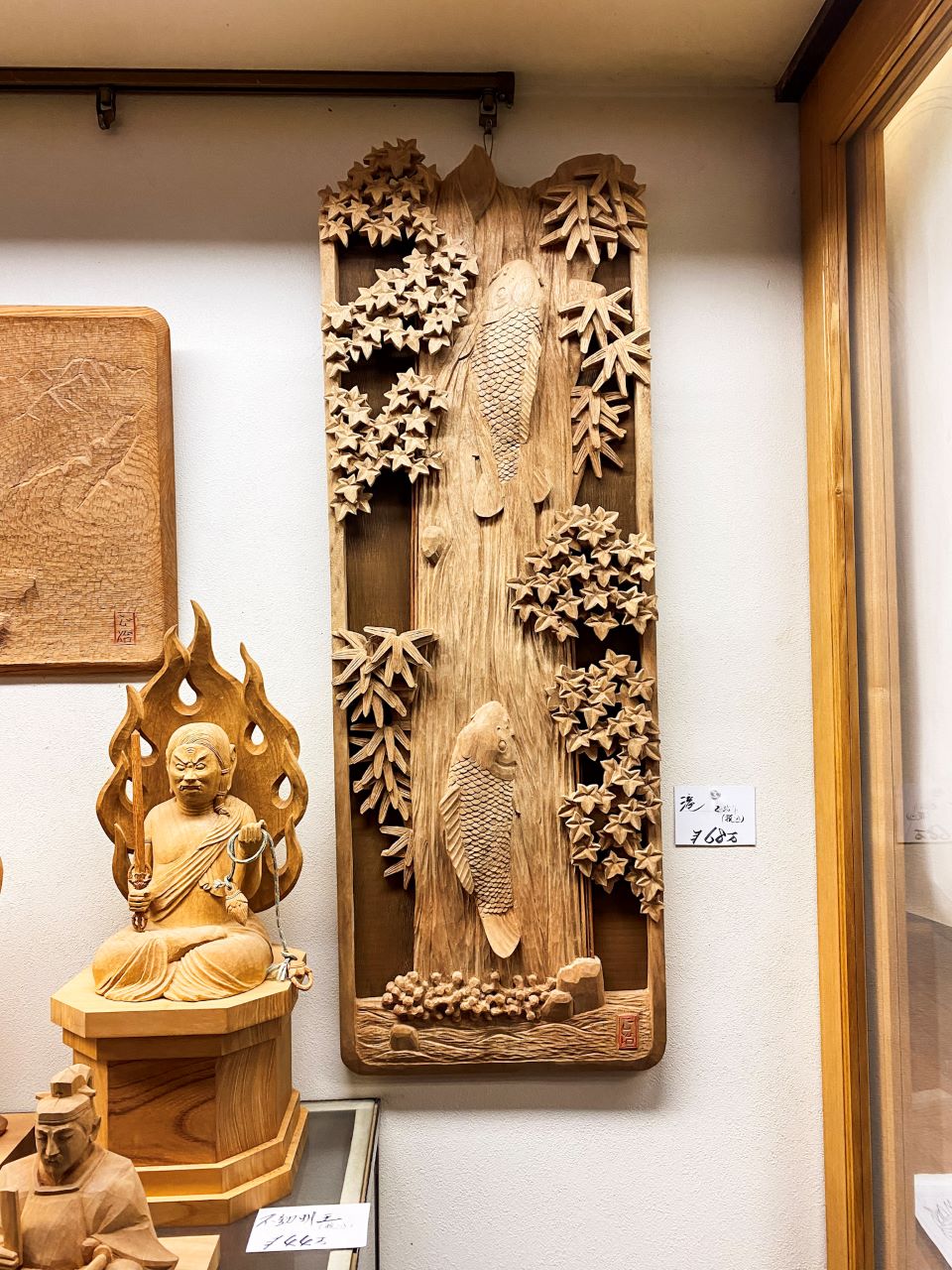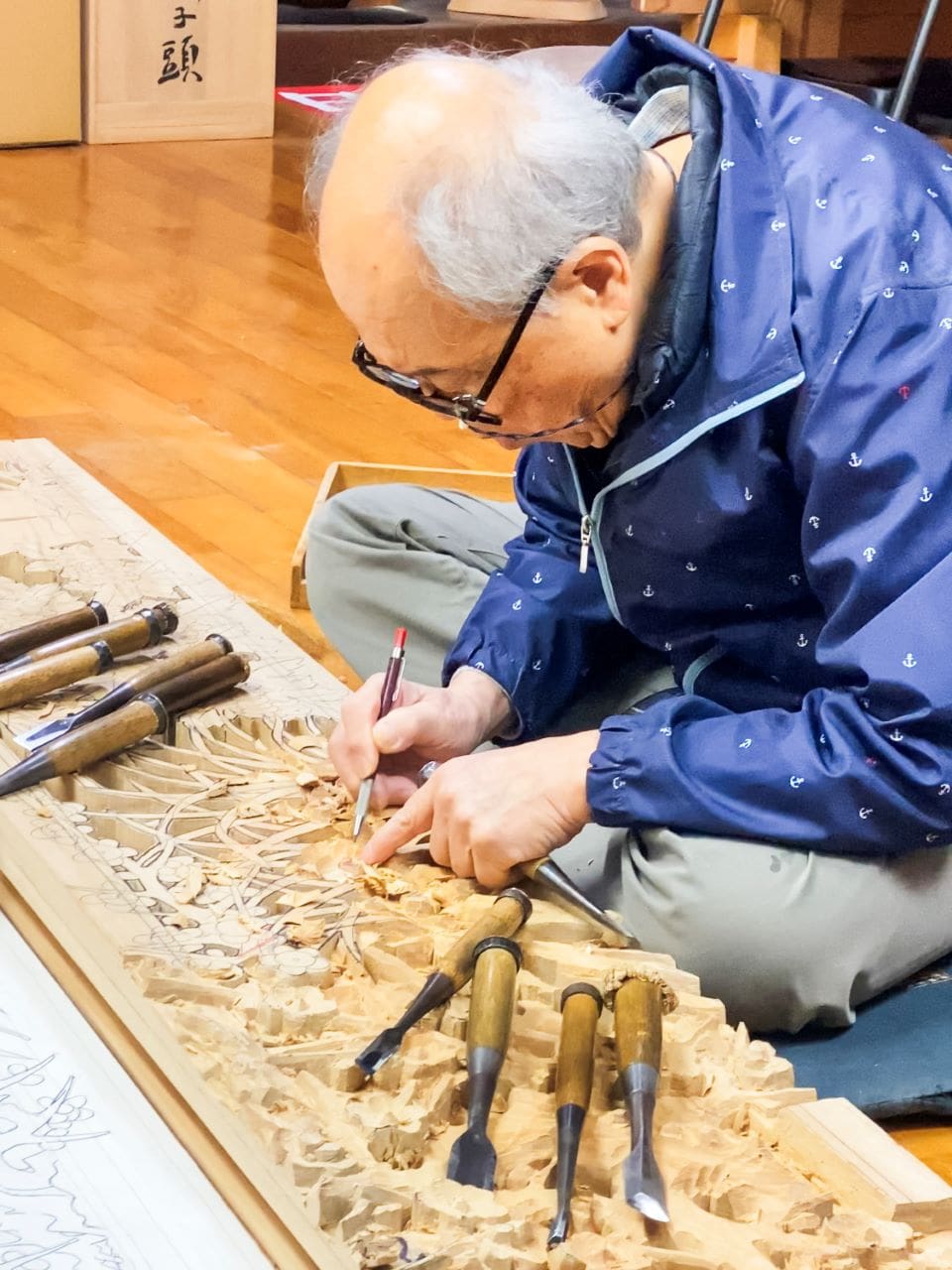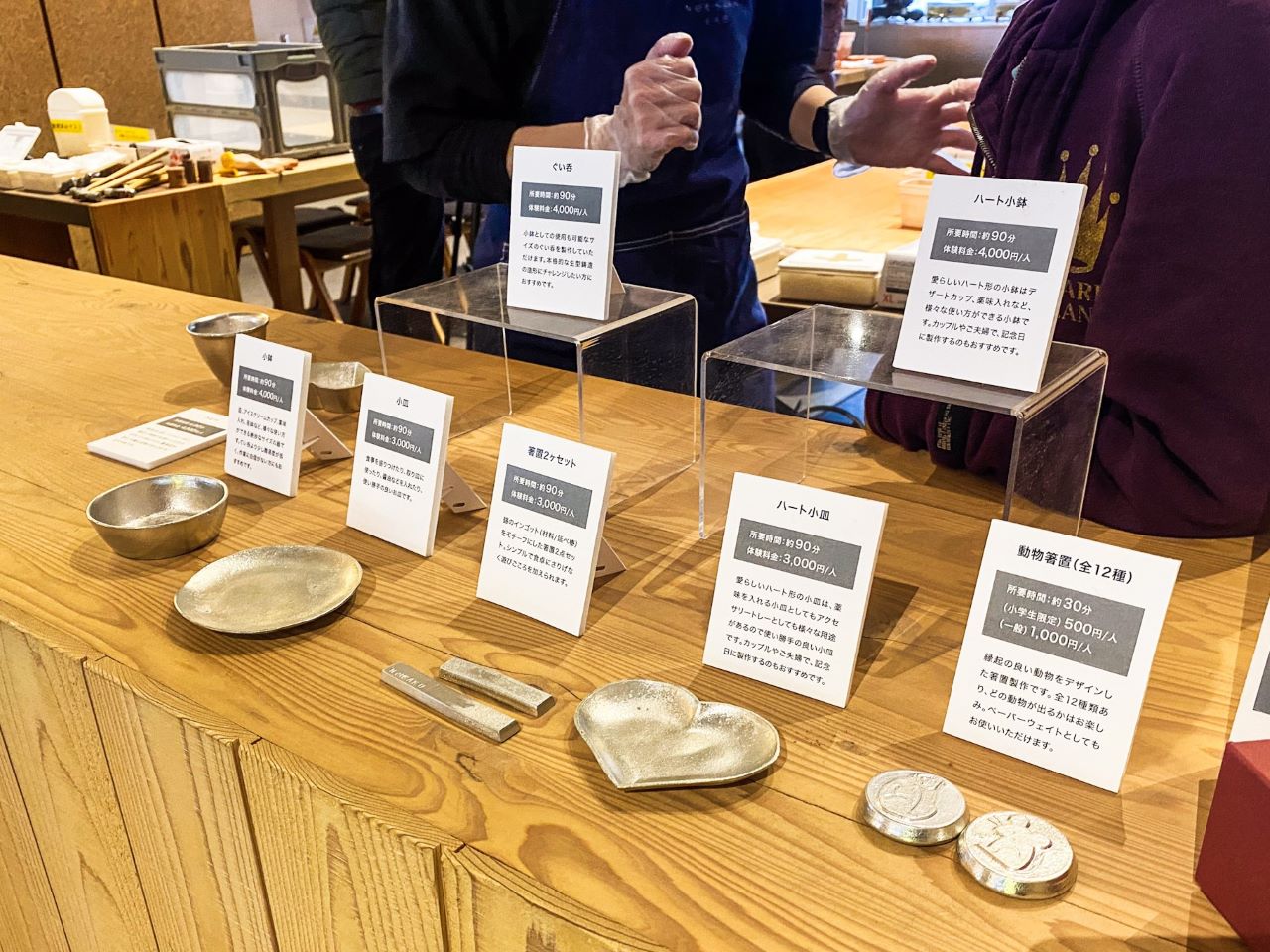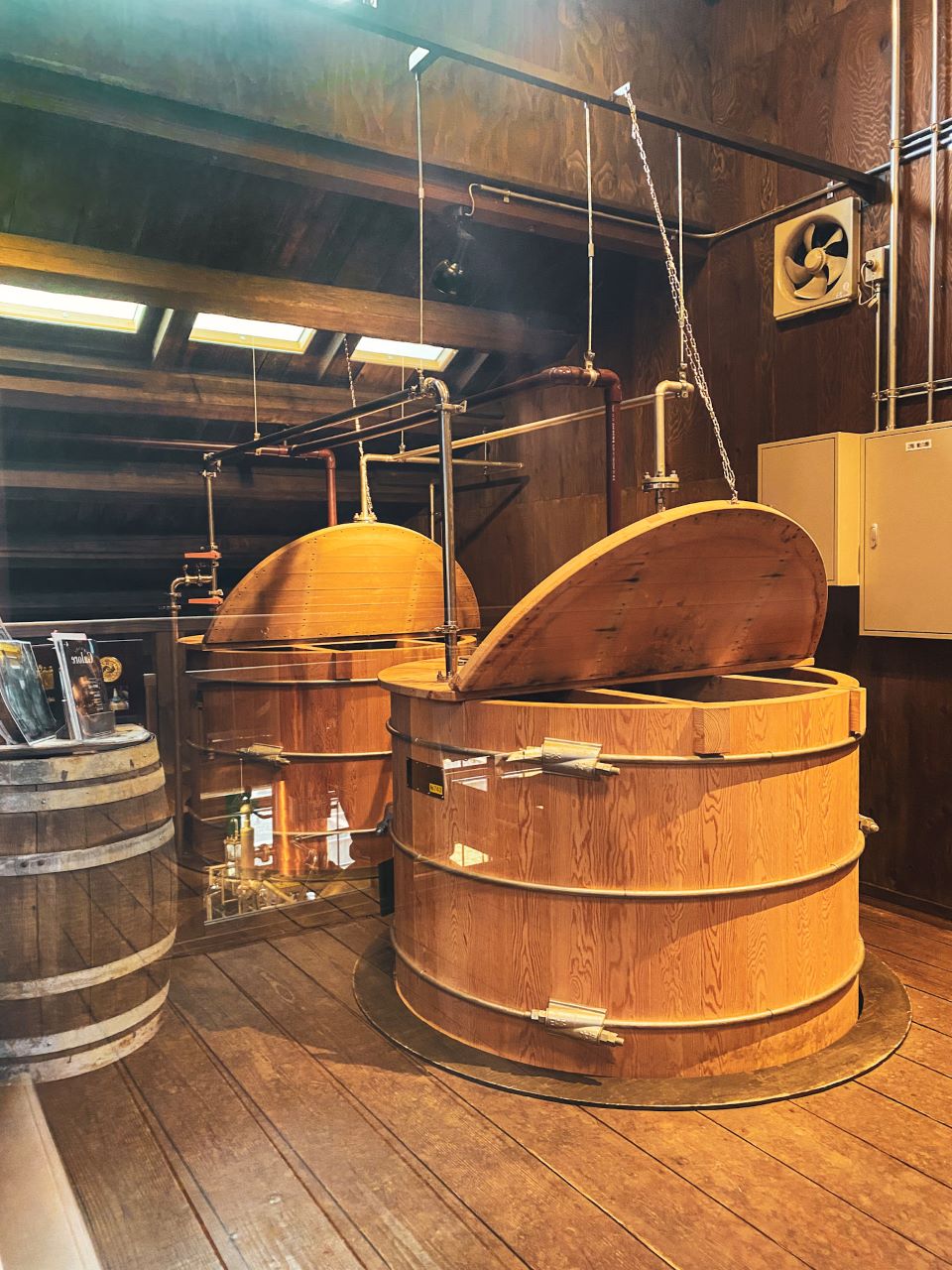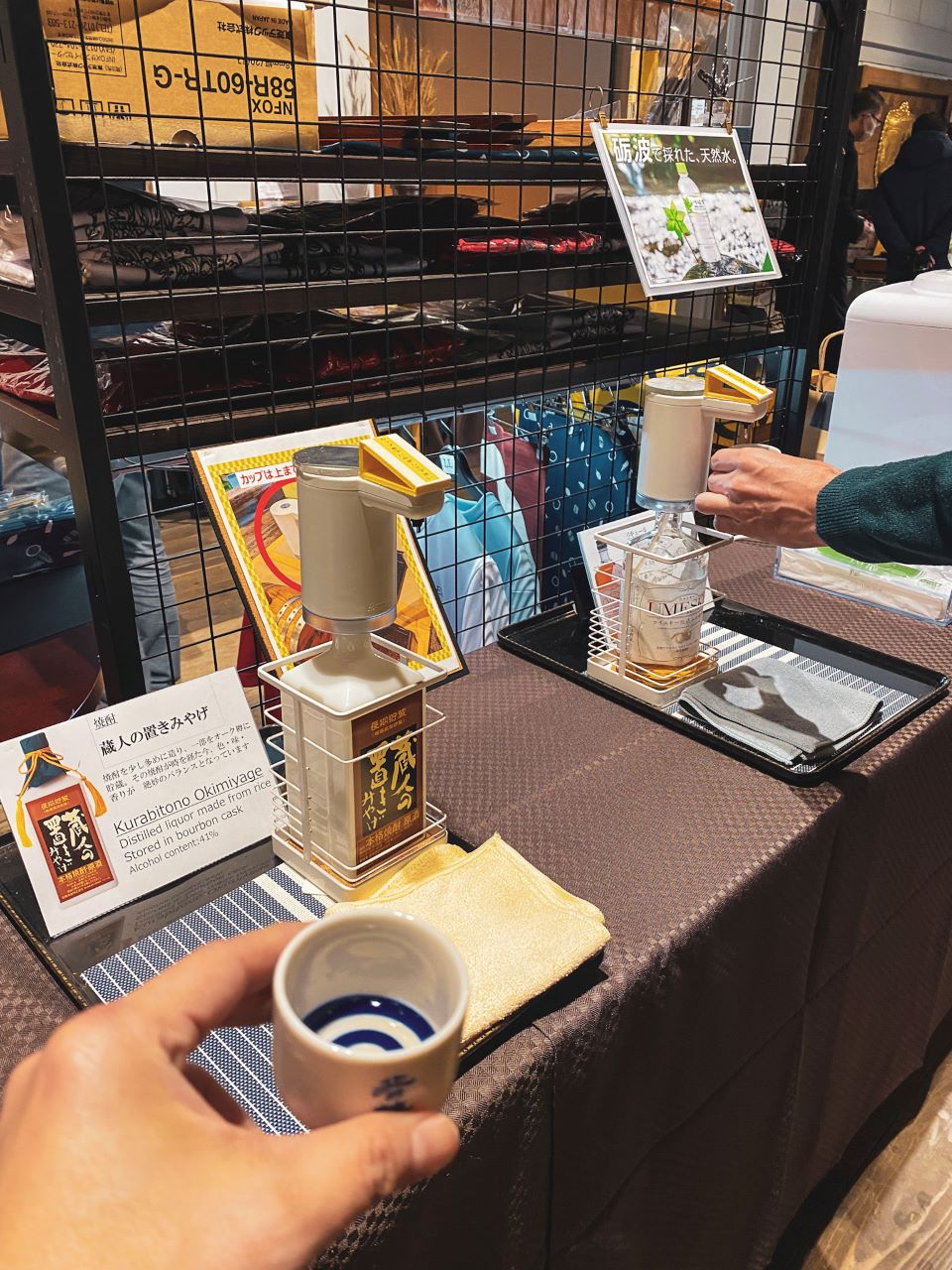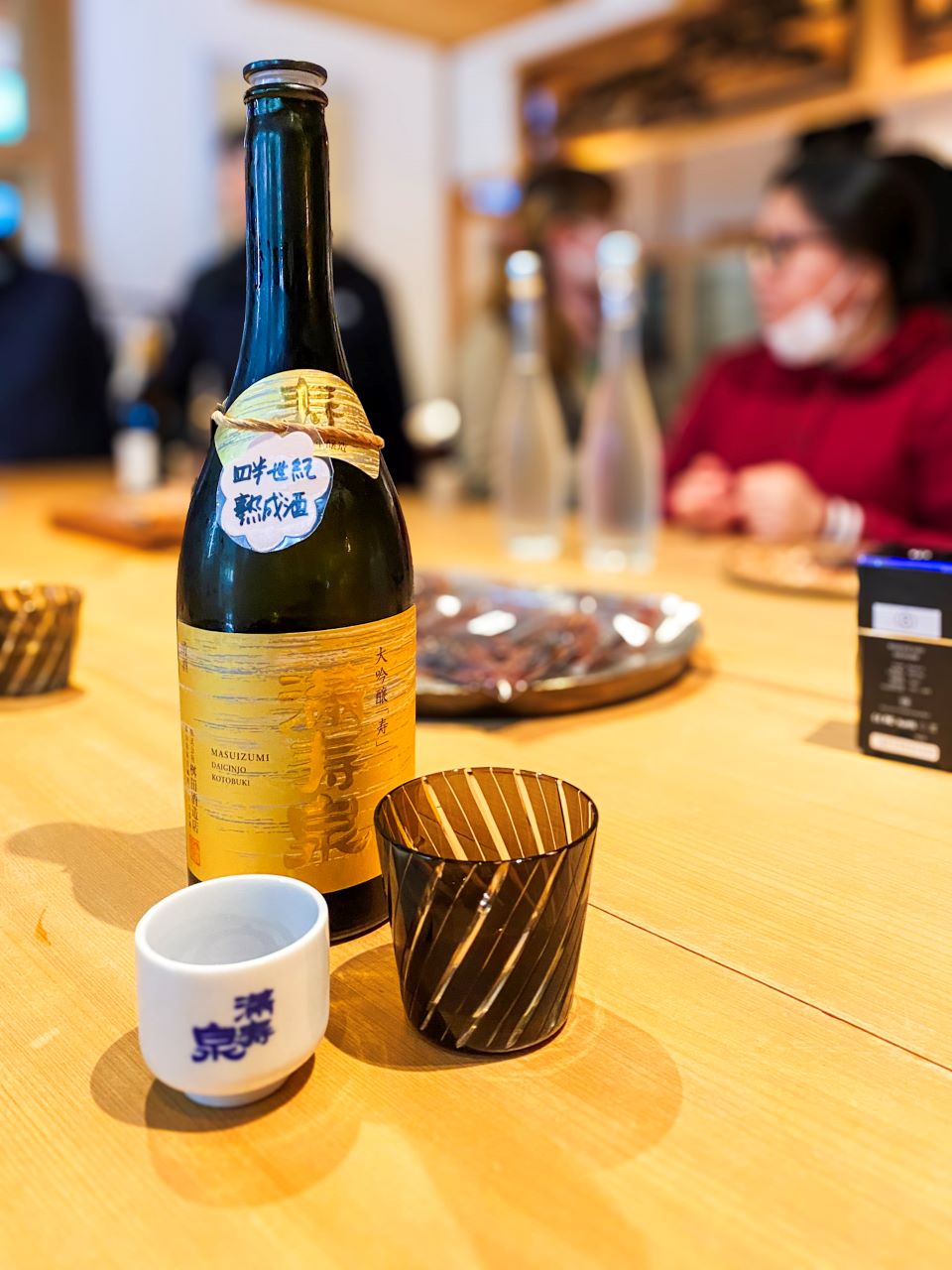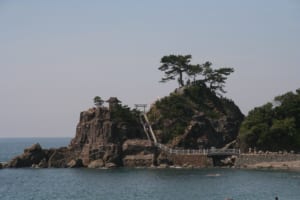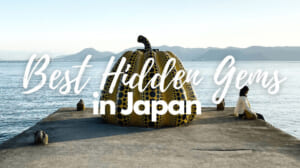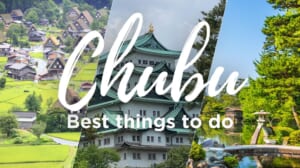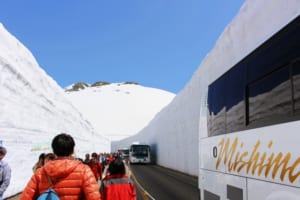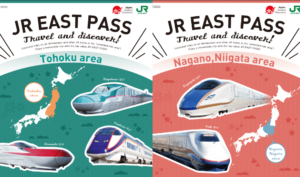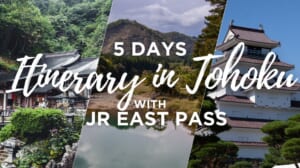3 Days Itinerary on the Hokuriku Route
Exploring Hokuriku: A 3-Day Adventure in Fukui, Ishikawa, and Toyama

Embark on an enchanting three-day journey through the Hokuriku region, a hidden gem between the Sea of Japan and the towering Japanese Alps. As we anticipate the Hokuriku Shinkansen extending its reach to Tsuruga in March 2024, opening up new vistas in Fukui Prefecture, the excitement is palpable.
This expansion signifies a golden opportunity to delve into the heart of Japan’s cultural and natural wonders. This carefully curated itinerary invites you to explore the unique blend of historical richness, scenic splendors, and modern innovation across Fukui, Ishikawa, and Toyama, offering an immersive experience of the essence of Hokuriku’s spirit.
*Please note that this article contains affiliate links.
▶ Buy your JR Hokuriku Arch Pass here!
▶ Buy your Bullet Train tickets here!
Day 1: Cultural Immersion in Fukui Prefecture
Fukui Prefecture (福井県), located in the Hokuriku region, offers a unique mix of natural beauty and cultural richness. The region’s main claim to fame is its vast richness when it comes to dinosaur fossils and its leading dinosaur museum, a legacy that can be felt all over the prefecture, captivating those interested in prehistoric wonders.
But beyond the fascinating creatures of yore, Fukui is also famous for its traditional crafts, including Echizen washi paper, a symbol of its historical heritage. The region’s cuisine, especially its fresh seafood, is a highlight for food lovers. Surrounded by scenic landscapes, including rugged coastlines and lush mountains, Fukui provides a peaceful yet engaging experience for travelers seeking a blend of history, art, and nature.
Port of Humanity Tsuruga Museum
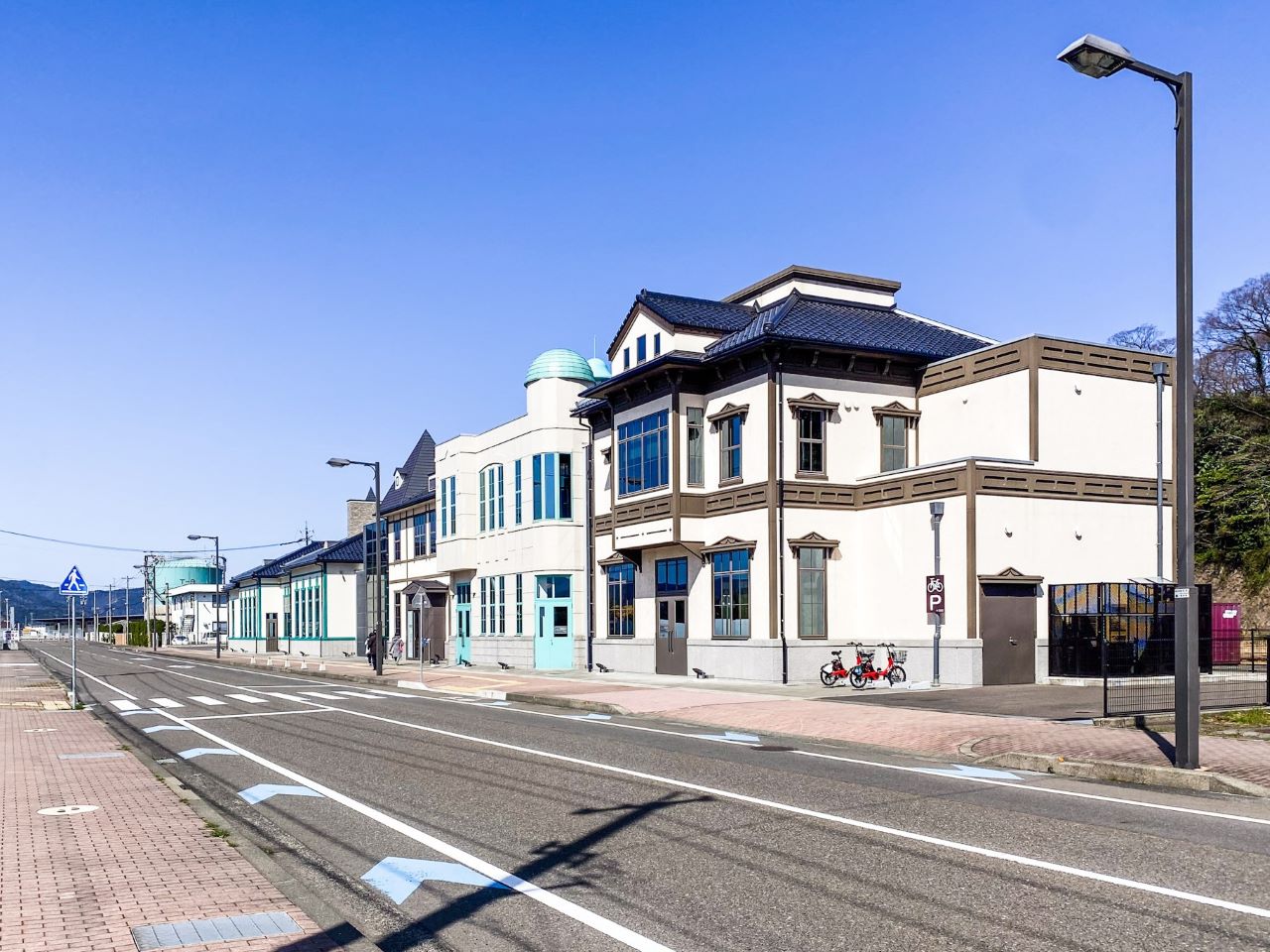 Our first stop after reaching Fukui from Tokyo was the Port of Humanity Tsuruga Museum (人道の港 敦賀ムゼウム).
Our first stop after reaching Fukui from Tokyo was the Port of Humanity Tsuruga Museum (人道の港 敦賀ムゼウム).
Consisting of restored Taisho and early Showa era buildings, including the original Port Station and Customs Luggage Inspection Station, Established in 2008 and reimagined in 2020, it chronicles Tsuruga’s role as a pivotal port for refugees, focusing on two significant historical events: the arrival of Polish orphans in the 1920s and Jewish refugees in the 1940s carrying “visas for life”.
This exhibit is enriched by the personal tales of residents and stories from the point of view of the orphans and refugees themselves, as well as some of their descendants, painting a vivid picture of the era and the port’s significant role as a sanctuary, and subsequent symbol of hope and compassion.
Lunch at Urushiya
After the educational and poignant experience at the museum, it was time for lunch, so we headed to Urushiya (うるしや), a historic restaurant with over 160 years of legacy specializing in Echizen soba noodles.
I was slightly surprised at the different colors and slightly spicier taste, which paired well with the delicious seasonal menu. Eating here is perfect for a taste of local history, as well as traditional ambiance with the gorgeous old building and the warm and inviting wooden interiors.
Paper and Cultural Heritage
A Legacy of Innovation at Igarashi Seishi
In the heart of Fukui lies a tradition that has shaped the very fabric of the region: the craft of washi paper-making. Igarashi Seishi (五十嵐製紙), established in 1919, is a bastion of this ancient art, creating exquisite paper that has found its way into stores and art galleries worldwide.
We were welcomed into the workshop to witness a blend of tradition and innovation, where food waste finds new life transformed in paper with unique textures and natural colors. Interestingly enough, this came to be thanks to the owner’s son, who had the idea for a school project!
Information
 Access Access |
20-min drive from Takefu Station |
|---|---|
 Official Website Official Website |
https://foodpaper.jp/index.html |
Okamoto-Otaki Shrine, Sanctum of the Paper Goddess
And since we were in the area, we had to stop by Okamoto-Otaki Shrine (岡太神社・大瀧神社), dedicated to Kawakami Gozen, the goddess of paper.
Surrounded by legend, this shrine pays homage to the mystical origins of Echizen paper-making, as local legend has it that it was taught by this celestial being over 1500 years ago. A small and charming spiritual space, the paper aspect is made evident in the cute and whimsical heart-shaped ema tablets, made of paper.
Information
 Access Access |
8-min walk from Igarashi Seishi |
|---|---|
 Official Website Official Website |
https://www.jinja-fukui.jp/detail/index.php |
Crafting Beauty by Hand at Yanase Ryozo Seishijo
Our paper journey continued at Yanase Ryozo Seishijo (柳瀬良三製紙所), this time with hands-on experience under the guidance of the descendants of Ryozo Yanase, the company’s founder.
The workshop’s washi, used in everything from confectionery packaging to artistic endeavors, is representative of the versatility and appeal of this craft, and it was a fascinating experience to watch several steps of the process. A highlight is the intricate process of kanagata rakusui-shi, where patterns emerge as water dances over metal molds, creating a fusion of strength and delicacy in the paper’s design, creating a nicely handmade souvenir in the process.
The Forged Legacy of Ryusen Hamono’s Craftsmanship
It was time to turn our attention to sharper materials to wrap up the day. Ryusen Hamono (龍泉刃物 本社) is a company that carries the torch of the Echizen uchihamono tradition, dating back over 700 years. From its post-World War II roots to its establishment in 1953, these blacksmiths have garnered acclaim for its exceptional stainless steel kitchen knives. The shop alone feels like a treasure trove for both professional chefs and culinary enthusiasts alike. We could even try cutting some vegetables to see for ourselves the quality of the knives.
The workshop showcases the meticulous forging process, where artisans shape and sharpen blades to perfection, showing the excellent craftsmanship of the region, grounded in traditional techniques.
Each knife, adorned with the signature ryusen-rin pattern, not only exemplifies sharpness but also carries the symbolic hope that, like the rising dragons in its design, the bearer’s wishes will soar to fulfillment. The best part? Visitors can also learn how to make their own knives under the careful guidance of these professional craftsmen!
Day 2: Artistry and Elegance in Ishikawa Prefecture
After a packed day learning about local crafts in Fukui, the 2nd day of our trip was going to be dedicated to Ishikawa Prefecture (石川県), a treasure trove of cultural richness and refined artistry. Home to the historic city of Kanazawa, often likened to a smaller Kyoto for its preserved districts and artisanal crafts, it stands as a proud guardian of Japanese heritage. Here, gardens bloom with tranquil beauty, markets bustle with the fresh catch of the day, and traditional workshops continue to thrive. Ishikawa invites travelers to step into a world where the legacy of samurai, the precision of gold leaf artisans, and the charm of geisha culture intermingle within daily life.
▶︎Best Things to Do in Ishikawa
The Art of Porcelain at Kutaniyaki Art Museum
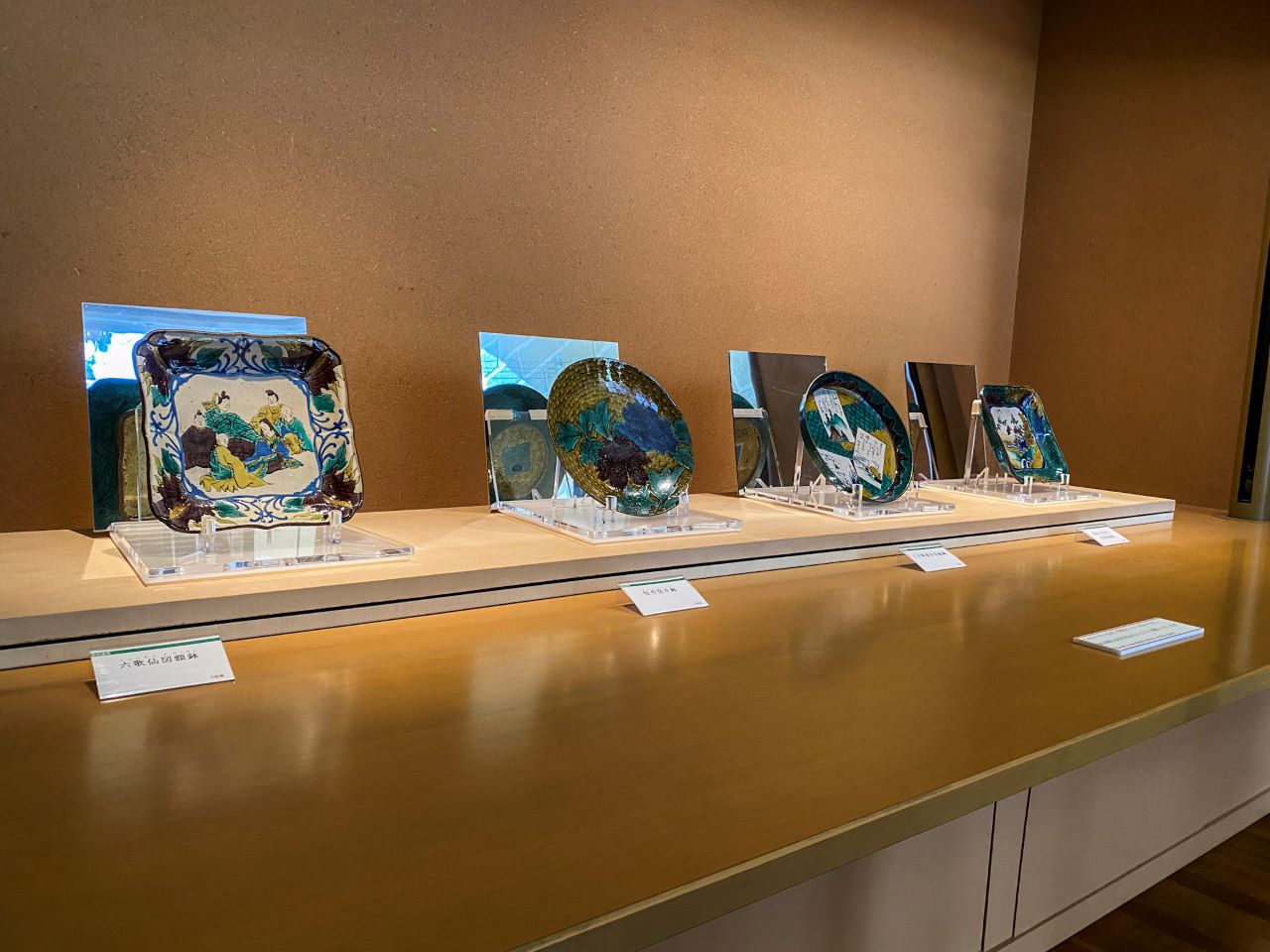 What better way to start in Ishikawa than visiting the Kutaniyaki Art Museum (石川県九谷焼美術館)? Located in Kaga, this is a sanctuary for the porcelain craft that has defined Ishikawa Prefecture for over 360 years. The museum, established in April 2002, is dedicated to the preservation and celebration of Kutani ware, known for its bold designs and colorful palette.
What better way to start in Ishikawa than visiting the Kutaniyaki Art Museum (石川県九谷焼美術館)? Located in Kaga, this is a sanctuary for the porcelain craft that has defined Ishikawa Prefecture for over 360 years. The museum, established in April 2002, is dedicated to the preservation and celebration of Kutani ware, known for its bold designs and colorful palette.
As we wandered through the exhibit, following our guides and their explanations, we admired the legacy captured in clay and the stories of cultural evolution. A fascinating aspect of Kutani wares has to do with its mysterious origins, with theories linking it to hidden Christians who adapted religious iconography into the colors and designs.
Also, blending past and present, at the time of our visit the museum was hosting the local initiative Wear Kutani, where local artists add a layer of contemporary appeal to traditional porcelain, transforming it into wearable art. We were able to attend a demonstration by Aikawa Shiho, a Kutani-yaki artist, showing the meticulous crafting process, from delicate brush strokes to the final firing that sets the bold vivid colors Kutani ware is known for.
Omicho Market, Kanazawa’s Culinary Hub
Leaving the museum without filling our bags with lovely souvenirs was challenging enough, and we still had to face Omicho Market (近江町市場), Kanazawa’s bustling culinary epicenter. This historic market, a staple for locals and tourists alike, teems with stalls offering an array of fresh seafood, seasonal produce, and artisanal goods, all enveloped in a lively atmosphere accentuated by the array of colors and scents from various vendors.
Naturally, it was here that we stopped for lunch. Ichinokura (市の蔵), an izakaya-style restaurant located within the market, is celebrated for its diverse and seasonal seafood dishes that reflect the authentic flavors of the region.
Masterpieces from Nature at Kenrokuen Garden
The deliciously generous lunch called for a stroll to fend off the post-meal drowsiness. So off we went to Kenrokuen Garden (兼六園), one of the three most beautiful gardens in Japan. This historical garden, evolving through centuries under the Maeda Clan, embodies the essence of Japanese garden design, balancing aesthetics with natural beauty, while the change of seasons offers a fresh spectacle at every visit.
Inside the garden, we didn’t pass up the chance to visit Shigure-tei (時雨亭). This architectural gem of a teahouse was reconstructed to reflect the Edo period’s elegance, providing a tranquil vantage point for garden views while we enjoyed a soothing cup of matcha and a small wagashi for some contemplative minutes.
Information
 Access Access |
20-min bus from Kanazawa Station |
|---|---|
 Official Website Official Website |
https://www.pref.ishikawa.jp/siro-niwa/kenrokuen/ |
Immersion in Tradition at Higashi Chaya and Nagamachi Districs
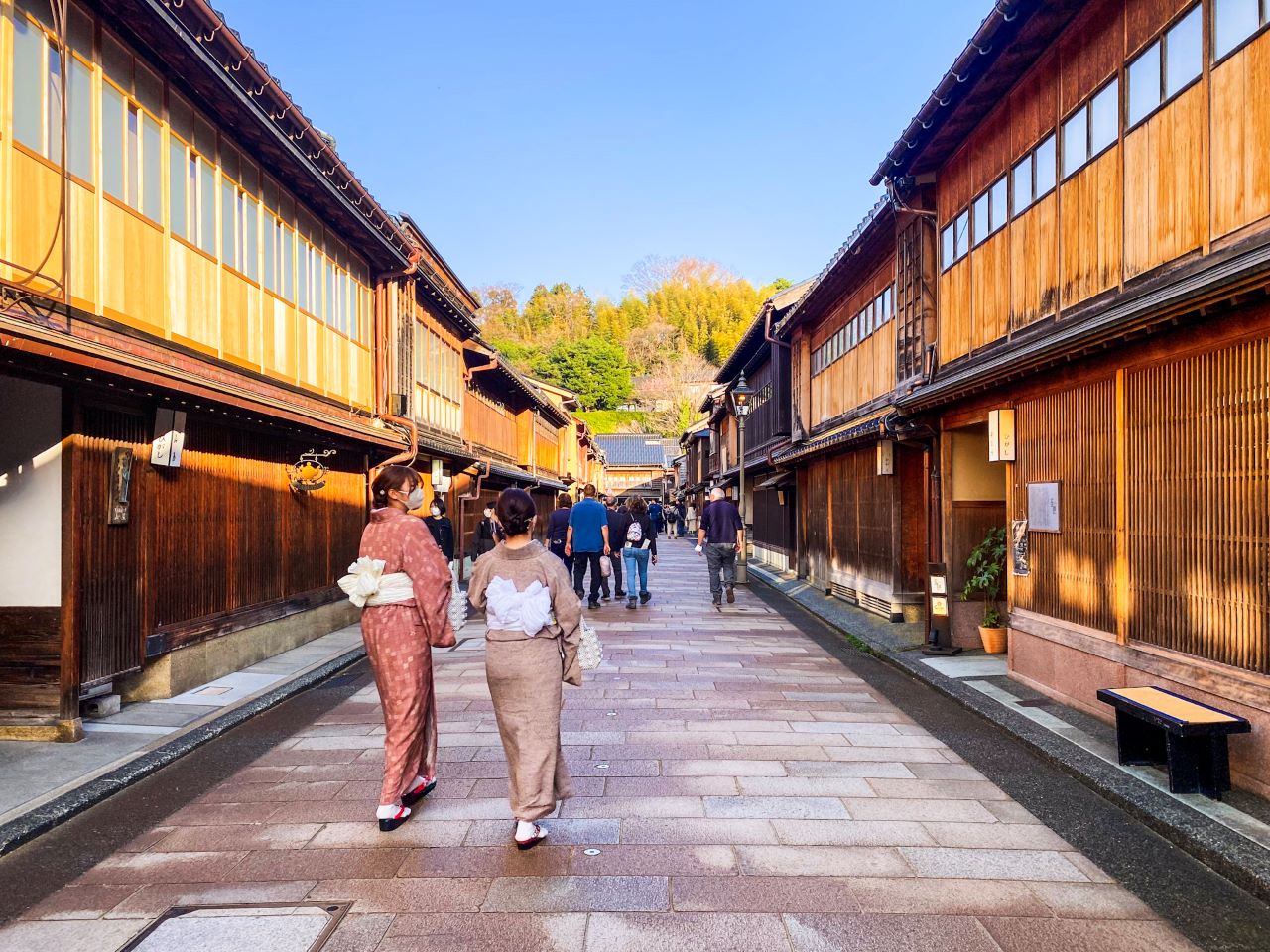
Feeling refreshed after the garden, it was time for some more fun and crafts! In Kanazawa’s Higashi Chaya District, the past comes alive along the narrow, cobblestone streets lined with preserved teahouses, most of them currently housing trendy shops and cafes. This area is a glimpse into the geisha world, showcasing traditional architecture and arts.
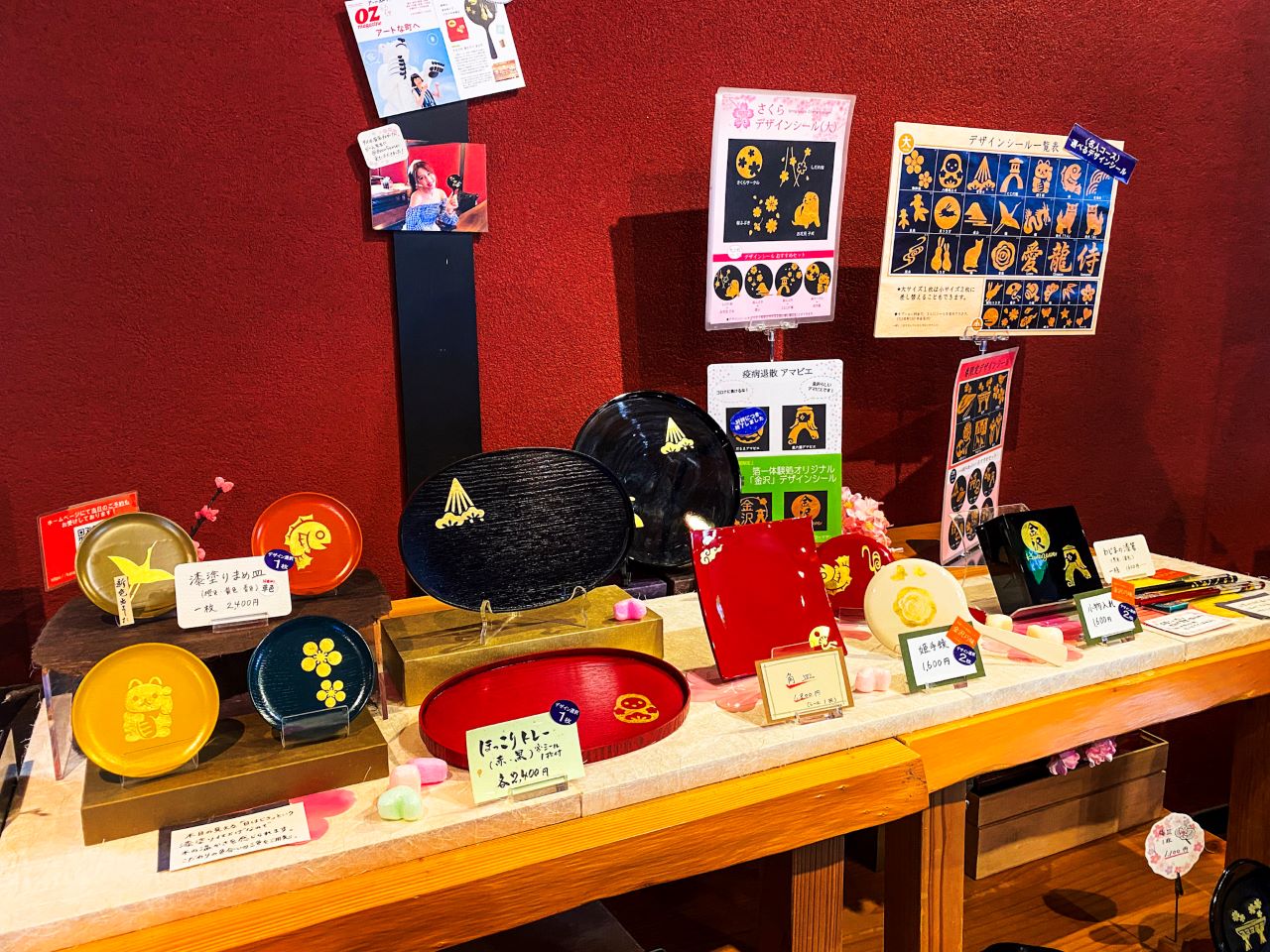 Given the widespread presence of gold leaf items and souvenirs, a hands-on gold leaf workshop at Kanazawa Bikazari Asano (かなざわ 美かざり あさの) is the perfect chance to participate in a craft integral to Kanazawa’s cultural identity. We were given the option to choose between a few different items like small trays or boxes, and take back home a lovely item that highlights the city’s artistic prowess.
Given the widespread presence of gold leaf items and souvenirs, a hands-on gold leaf workshop at Kanazawa Bikazari Asano (かなざわ 美かざり あさの) is the perfect chance to participate in a craft integral to Kanazawa’s cultural identity. We were given the option to choose between a few different items like small trays or boxes, and take back home a lovely item that highlights the city’s artistic prowess.
▽Don’t miss our Kanazawa Shopping Guide!▽
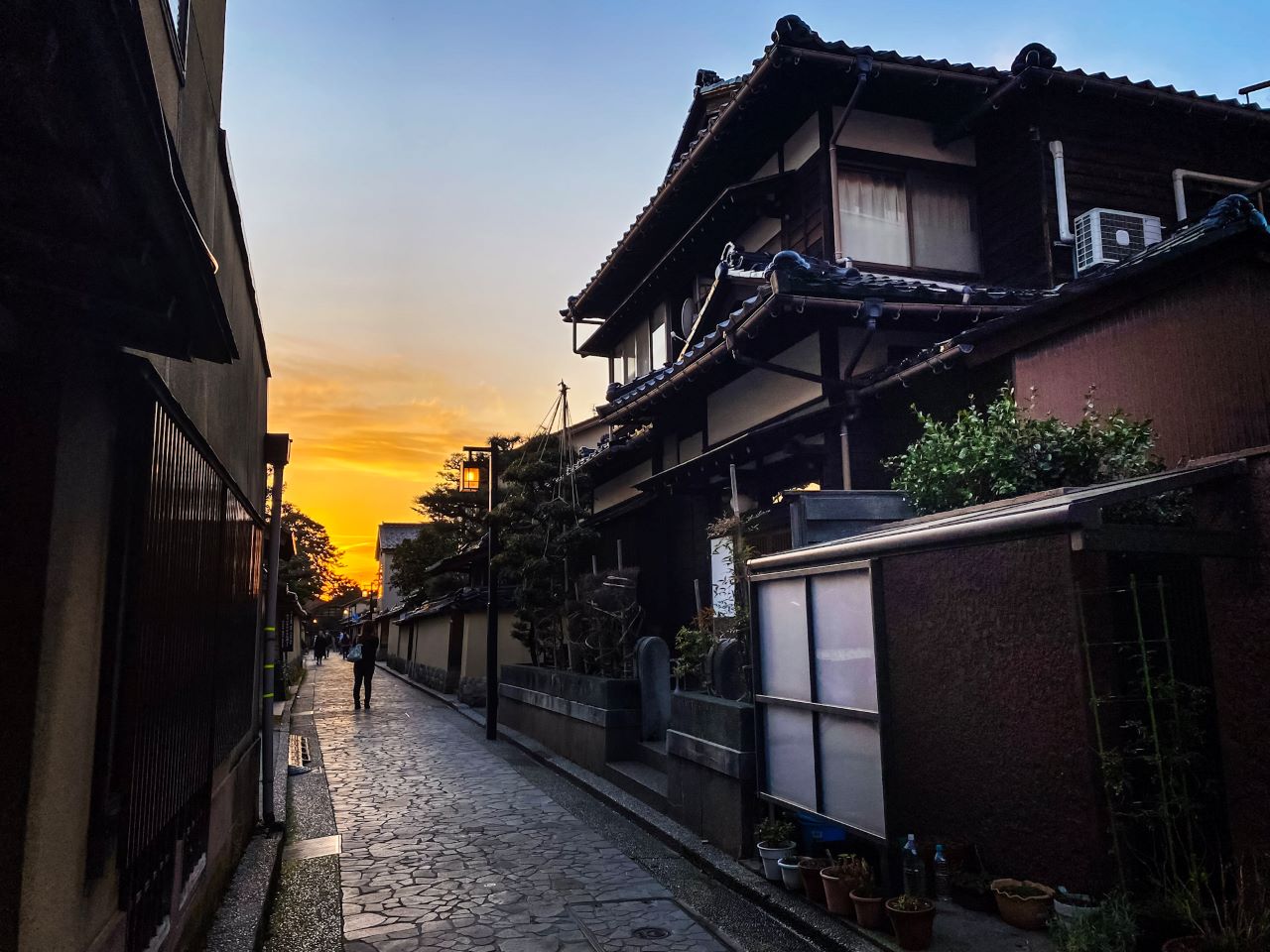 The day’s exploration culminates with a short walk leading to the Nagamachi Samurai District, a neighborhood that encapsulates the disciplined yet culturally rich lifestyle of the samurai era, where the legacy of the samurai class is preserved in well-maintained residences and stone-paved lanes.
The day’s exploration culminates with a short walk leading to the Nagamachi Samurai District, a neighborhood that encapsulates the disciplined yet culturally rich lifestyle of the samurai era, where the legacy of the samurai class is preserved in well-maintained residences and stone-paved lanes.
Day 3: Discovering Toyama’s Hidden Gems
The third and last day of our trip was dedicated to Toyama Prefecture (富山県), along the Sea of Japan and bordered by the majestic Northern Alps. This region is known for its dramatic landscapes ranging from rugged mountain terrains to serene coastal vistas, a location that nurtured a melting pot of history and culture. The region boasts rich artisan traditions, including esteemed metalwork and woodworking, alongside unique culinary delights like the renowned Toyama Bay sushi. As a gateway to ancient trade routes and a hub for contemporary arts, Toyama offers a journey through time and an immersion in Japan’s multifaceted heritage.
Traveling Back in Time at Gokayama’s Ainokura Village
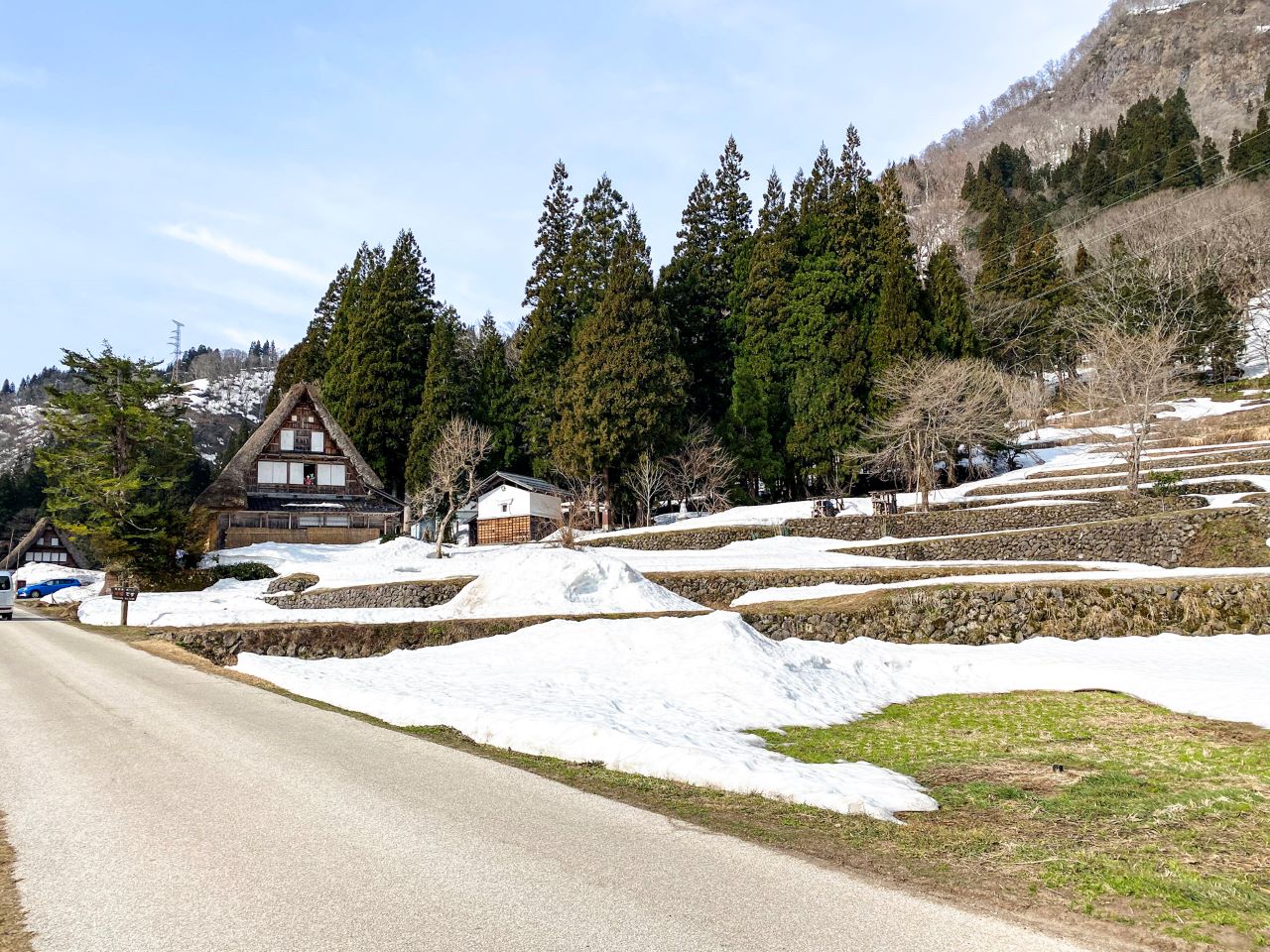 Starting the day on a high note, our first stop was Gokayama (五箇山), a region of profound historical and natural beauty, that is home to Ainokura Village, part of the UNESCO World Heritage site. Ainokura, with its well-preserved gassho-zukuri houses, offers a timeless glimpse into Japan’s rural past.
Starting the day on a high note, our first stop was Gokayama (五箇山), a region of profound historical and natural beauty, that is home to Ainokura Village, part of the UNESCO World Heritage site. Ainokura, with its well-preserved gassho-zukuri houses, offers a timeless glimpse into Japan’s rural past.
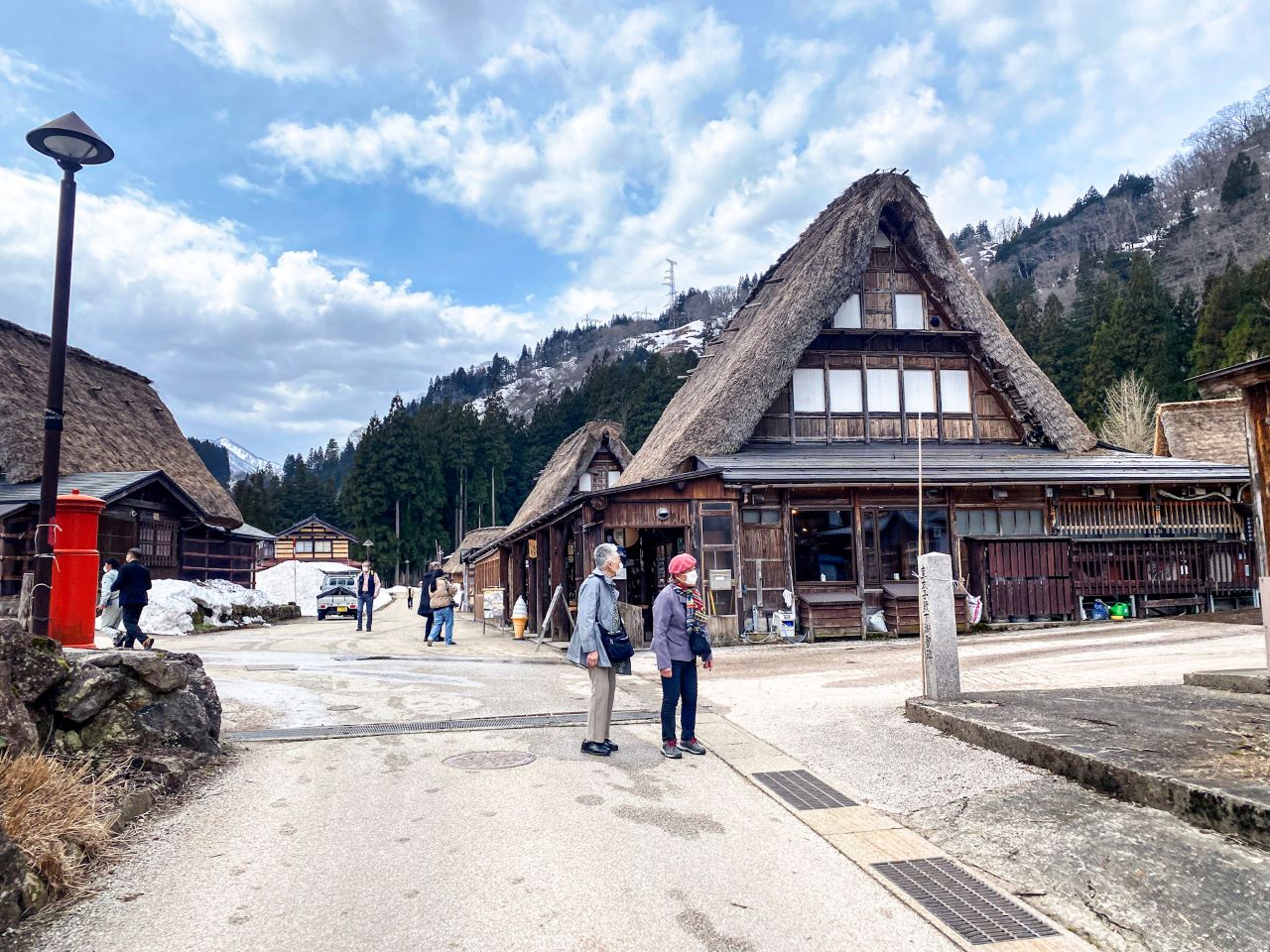 These steeply thatched roofs are designed to withstand harsh natural mountain conditions such as heavy snowfall, marrying charm and convenience into an architectural treasure. As we wandered through the village, it was easy to feel transported to a bygone era, untouched by the rapid pace of modern life.
These steeply thatched roofs are designed to withstand harsh natural mountain conditions such as heavy snowfall, marrying charm and convenience into an architectural treasure. As we wandered through the village, it was easy to feel transported to a bygone era, untouched by the rapid pace of modern life.
▶Book an Art Tour in Gokayama here!
At the heart of this rustic idyll is the Exhibition Hall Yusuke (民宿 勇助), a traditional gassho-zukuri house dating back to 1868. Now serving as both a museum and a guesthouse, it provides an immersive experience into the historical lifestyle of the region, showcasing an array of artifacts and exhibits, each narrating stories of the local culture and the architectural significance of gassho-zukuri structures.
Yusuke’s owner, Ikehata Shigeru, is also an accomplished photographer who has lovingly documented the village lifestyle and history, and whose photos can be seen on display in the 2nd floor. Ikehata san himself shared with us explanations about the house and local history and culture as we were sitting around the irori hearth, a central feature in these homes, adding warmth and inviting us to experience communal aspects of traditional Japanese life.
The Charm of an Ancient Dance
Our visit was made even more memorable with the enchanting Kokiriko dance (こきりこ踊り). The dancers, part of the Gokayama Folk Song Preservation Society, provide an entertaining and educational experience about the deep-rooted traditions of this unique region. Originating in the region over a millennium ago, the dance is a vibrant expression of Gokayama’s cultural spirit. Performed with a bamboo instrument called sasara, it creates a rhythmic melody that’s harder to reproduce than it seems. After the dance, we were kindly allowed to try our hand at playing the sasara so the skill gap was quite evident!
The Wooden Treasures of Inami District
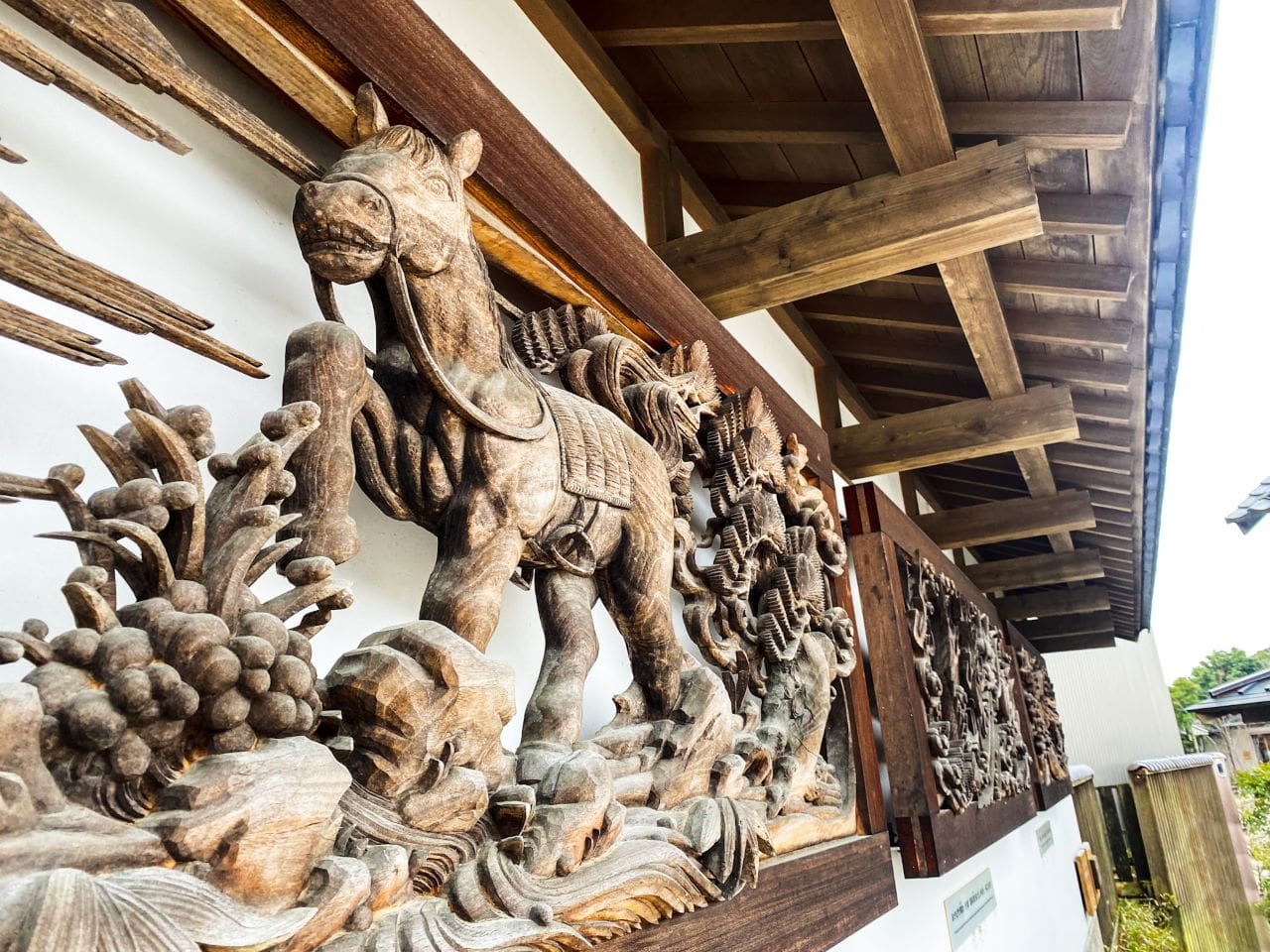
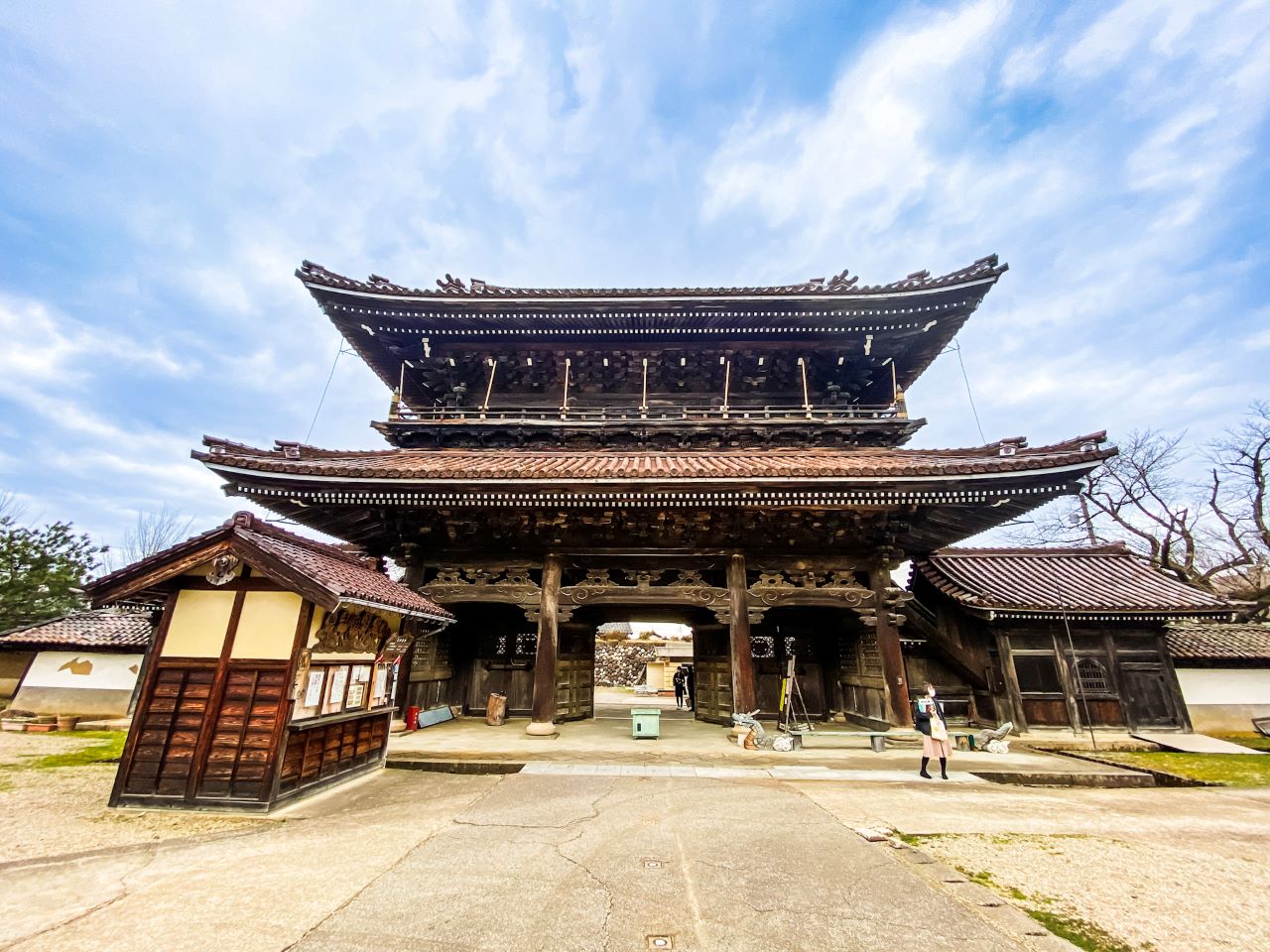 As fascinating as our Ainokura experience was, we had to continue. Our next destination was the serene Inami district (井波町) of Nanto City, a place where a rich tradition of woodcarving, dating back over 250 years, continues to flourish. Inami is renowned for its Betsuin Zuisenji Temple (井波別院瑞泉寺), founded in 1390, which is considered the birthplace of Inami woodcarving.
As fascinating as our Ainokura experience was, we had to continue. Our next destination was the serene Inami district (井波町) of Nanto City, a place where a rich tradition of woodcarving, dating back over 250 years, continues to flourish. Inami is renowned for its Betsuin Zuisenji Temple (井波別院瑞泉寺), founded in 1390, which is considered the birthplace of Inami woodcarving.
This art form was significantly influenced by Kyoto carvers, who brought their skills to the area when said temple had to be rebuilt in 1885 after a fire, and thus laying the foundation for what would become a distinguished local craft. Suffice to say, the temple is the district’s crown jewel. The main hall is considered one of Japan’s finest wooden buildings. Its reconstruction, which involved local architects, carvers, and painters, took seven years to complete, resulting in a truly exquisitely adorned structure.
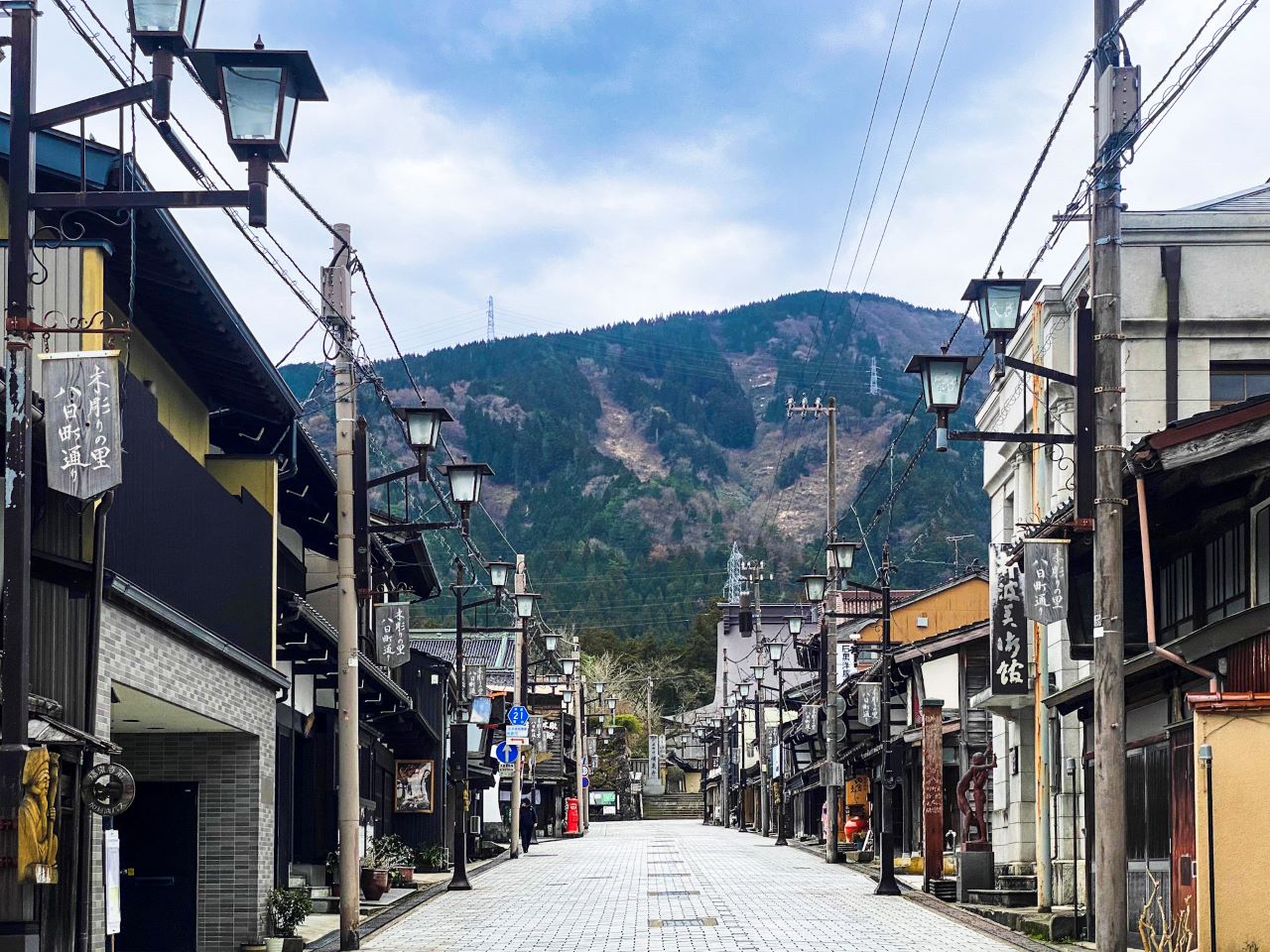
Yokamachi-dori, a symbolic street of the Inami district, is lined with woodcarving workshops, as well as beautifully carved facades and whimsical motifs adorning lamp posts or street corners. The district artisans employ a wide variety of different chisels and carving knives to create intricate designs, showcasing some of the finest carving techniques in Japan and ranging from elaborate temple decorations to smaller, more personal items.
We took almost forever stopping nearly at every shop and at every spot just admiring all the small little details and being mesmerized by the skills of the artisans working in their workshops. But the street charm doesn’t stop at the aesthetic value, there’s also an auditory experience to be had while strolling.
Those are the unique sounds of chisels and mallets at work, which have received official recognition as one of Japan’s Best Hundred Soundscapes. A rhythmic tapping and scraping that has defined the soundscape of Inami for centuries.
Information
 Access Access |
20-min bus from Fukumitsu Station |
|---|---|
 Official Website Official Website |
https://www.info-toyama.com/attractions/80089 |
Lunch at Farm Restaurant Ookado
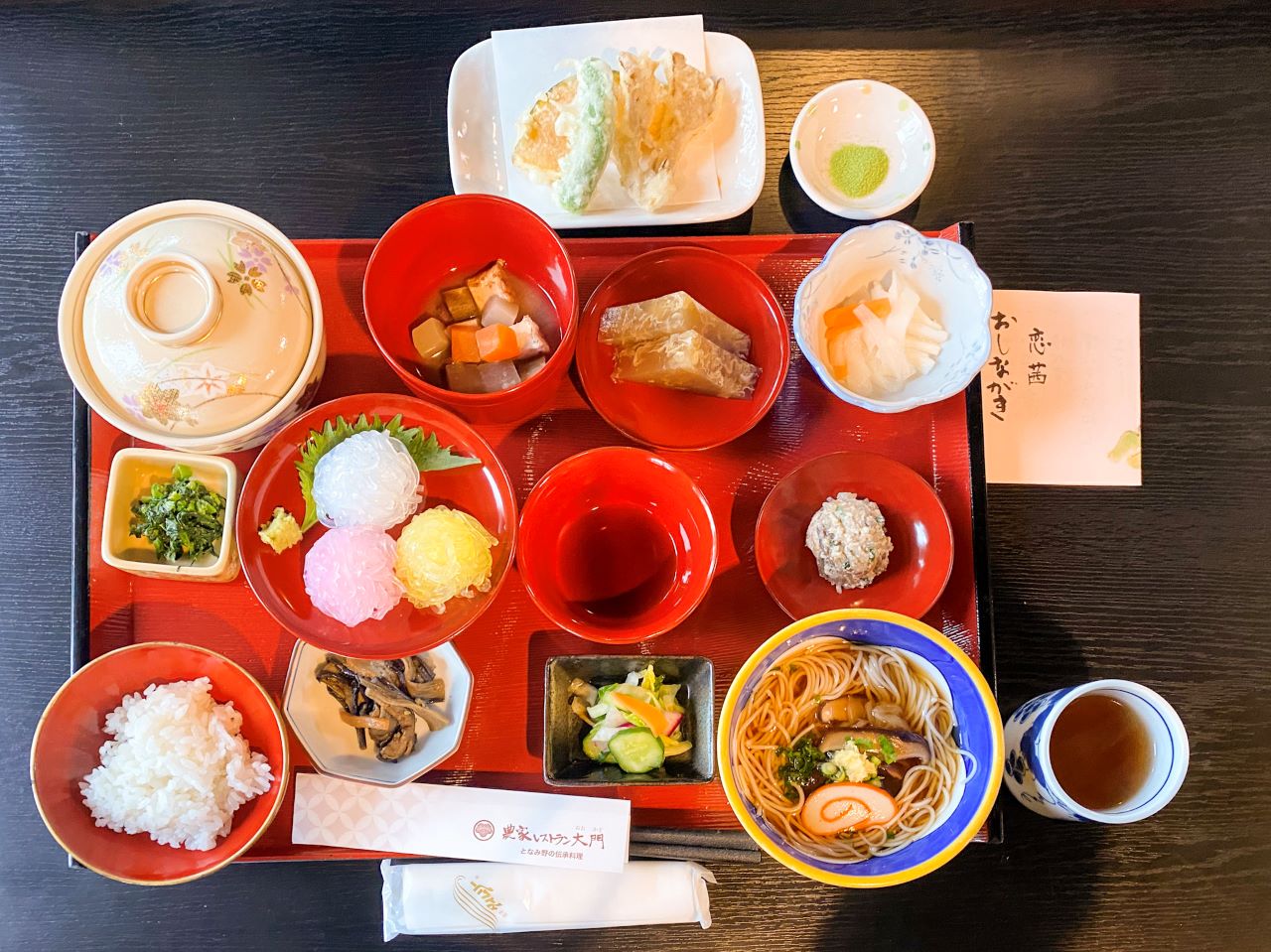 Our souls were filled to the brim with aesthetical joy, but before long we found ourselves in need of some earthly nourishment. Why not both, you’d say…? Well, that’s right, you could probably say that Farm Restaurant Ookado (農家レストラン大門) achieves exactly that. Both. A culinary experience deeply rooted in the region’s agrarian traditions. This charming eatery, set in a rustic, welcoming ambiance, serves dishes crafted from locally sourced, seasonal farm-fresh ingredients.
Our souls were filled to the brim with aesthetical joy, but before long we found ourselves in need of some earthly nourishment. Why not both, you’d say…? Well, that’s right, you could probably say that Farm Restaurant Ookado (農家レストラン大門) achieves exactly that. Both. A culinary experience deeply rooted in the region’s agrarian traditions. This charming eatery, set in a rustic, welcoming ambiance, serves dishes crafted from locally sourced, seasonal farm-fresh ingredients.
Nousaku, Where Cast Metal Tradition Meets Innovation
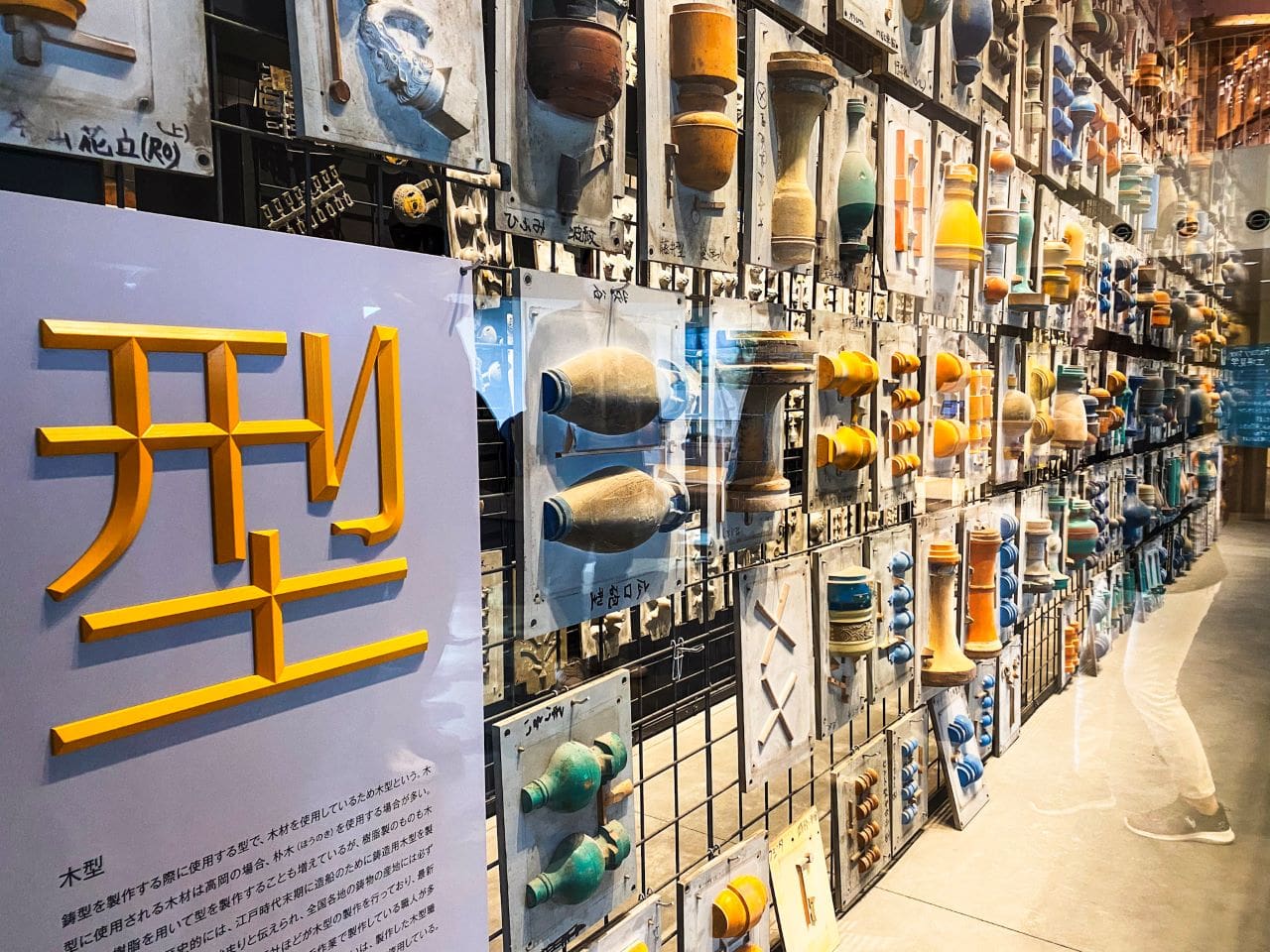
Keeping the theme of soul-related matters, our next destination after lunch was the headquarters of a company that initially developed its craft with Buddhist bells and tea ceremony utensils. Nousaku Co. (能作 本社工場) was established in 1916 in Takaoka, a city with a rich history in metal casting dating back to the 17th century. Over time, under the leadership of Katsuji Nousaku, the company expanded its range to include tableware and interior items, creatively using 100% tin.
Nousaku’s commitment to traditional techniques, coupled with a keen eye for contemporary design, has led to the creation of products that are both functional and artistically significant. At their award-winning factory and workshop, we had the unique opportunity to witness the fusion of age-old casting methods with modern product development, and participate in a fun workshop to get a closer look at the manufacturing process.
Wakatsuru Saburomaru Distillery
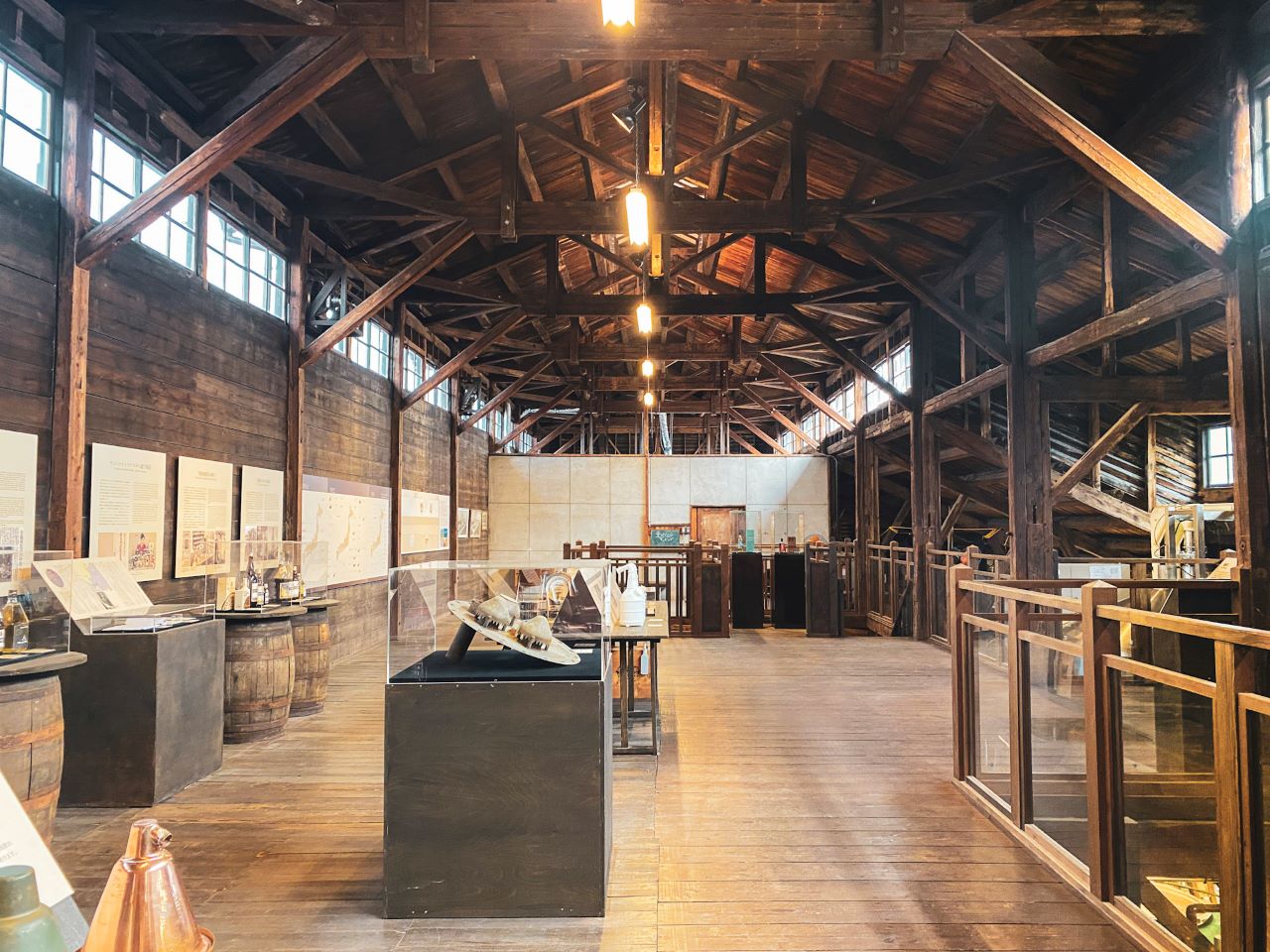
A short drive away from Nousaku, we reached Wakatsuru Saburomaru Distillery (若鶴酒造), a symbol of the region’s innovative spirit in whisky making. Founded in 1952 as part of Wakatsuru Brewery, the distillery started its journey in post-war Japan, initially focusing on sake production and then transitioning to whiskey production, releasing its first whiskey and labeling it as Sunshine Whiskey, to symbolize hope and rejuvenation amid a post-war context.
At the distillery, we learned about the intricate process, from the careful selection of ingredients to the meticulous distillation process. The focus on a smoky aroma sets their products apart, offering a unique taste profile that has garnered acclaim in the whisky world. The distillery, while rooted in tradition, has adapted to contemporary tastes, earning awards at international whisky competitions. The best part? The tasting of their entire lineup at the end of the visit!
Iwase District: Toyama’s Historical Maritime Gateway
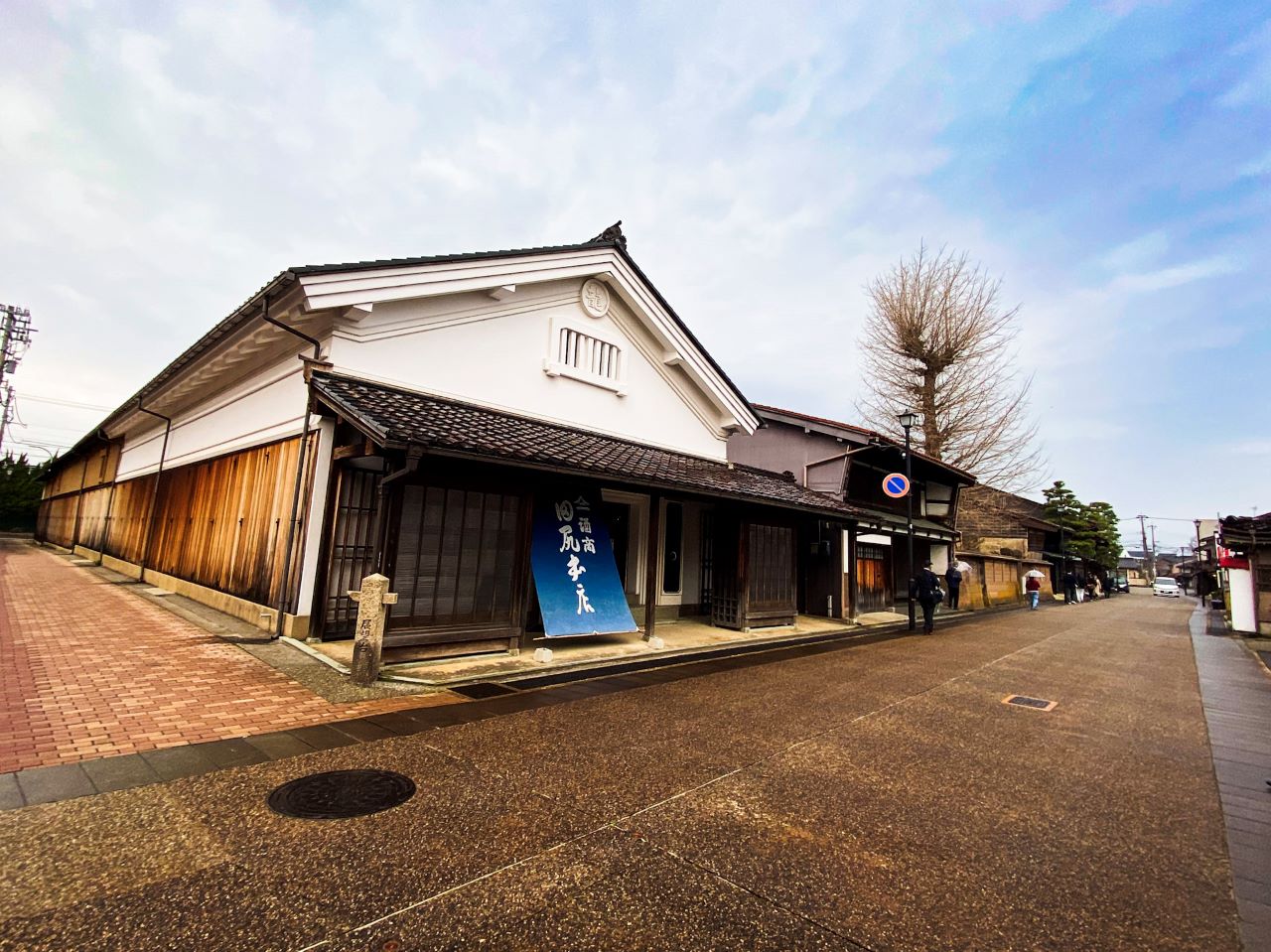 As tempting as it was to continue, our fun-tasting session came to an end. But just because we had some more to try somewhere else! Our final stop for the day was Iwase District (岩瀬町) in Toyama City, once a bustling port town during the Edo Period (1603-1867). It thrived as a vital hub for Kitamaebune cargo ships navigating the Sea of Japan, connecting Osaka to Hokkaido. The district’s historical significance is reflected in its architecture, with many buildings dating back to the Meiji Period (1868-1912).
As tempting as it was to continue, our fun-tasting session came to an end. But just because we had some more to try somewhere else! Our final stop for the day was Iwase District (岩瀬町) in Toyama City, once a bustling port town during the Edo Period (1603-1867). It thrived as a vital hub for Kitamaebune cargo ships navigating the Sea of Japan, connecting Osaka to Hokkaido. The district’s historical significance is reflected in its architecture, with many buildings dating back to the Meiji Period (1868-1912).
Our guide walked us through the area’s rich maritime heritage, palpable in the well-preserved merchant houses and storehouses that lined the Omachi Niikawamachi street (大町新川町通り), echoing the prosperity brought by the shipping trade. Some of them currently house trendy shops and bars, like Saseki, a fairly new addition to the area opened in 2019 by the historical Masuda Brewery. Saseki was a one-of-a-kind bar, where we had the opportunity to taste to our heart’s content out of a selection of 100 varieties produced by Masuda, including vintage and rare products that aren’t normally for sale.
The external design contrasted the sleek yet traditionally inspired interiors, as we delighted ourselves with their products while thanking the heavens none of us had to drive that day. It was the perfect way to finish our schedule for the day, before heading to Toyama Station to catch our train back to Tokyo.
Information
 Access Access |
10-min walk from Keirinjo-Mae or Hihashi-Iwase Stations |
|---|---|
 Official Website Official Website |
https://visit-toyama-japan.com/en/places-to-go/80026 |
This three-day journey through the Hokuriku region, filled to the brim with cultural experiences, was a genuine insight into the regional soul of Japan, revealing stories and crafts that have been lovingly preserved through the ages. The resilience of traditions, the warmth of the people, and the unspoiled beauty of the landscapes have left an indelible mark, making the Hokuriku route a truly unforgettable experience.
▶ Buy your JR Hokuriku Arch Pass here!
▶ Buy your Bullet Train tickets here!
▽Subscribe to our free news magazine!▽
For more information about traveling in Japan, check these articles below, too!
▽Related Articles▽
▼Editor’s Picks▼
Written by
Photographer, journalist, and avid urban cyclist, making sense of Japan since 2017. I was born in Caracas and lived for 14 years in Barcelona before moving to Tokyo. Currently working towards my goal of visiting every prefecture in Japan, I hope to share with readers the everlasting joy of discovery and the neverending urge to keep exploring.





